#cinema turco
Photo

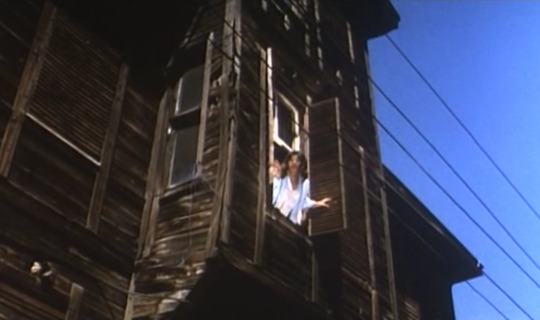




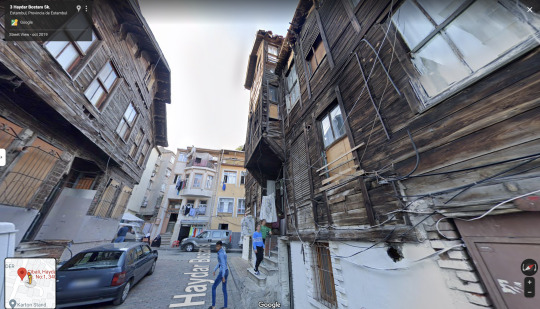


Hamam / Steam: The Turkish Bath
Ferzan Özpetek. 1997
House
Haydar Bostanı Sk. No:1, Cibali 34083 Fatih/İstambul, Turkey
See in map
See in imdb
#ferzan özpetek#hamam#il bagno turco#steam#the turkish bath#istambul#turkey#fatih#alessandro gassmann#francesca d'aloja#movie#cinema#film#location#google maps#street view#1997
53 notes
·
View notes
Text
audio dell'incontro / confronto / dialogo sui video proiettati il 17 aprile 2023 allo studio campo boario
Gli audio fanno riferimento al confronto pubblico con gli spettatori dei video proiettati nel contesto della rassegna Incontri ravvicinati tra arte e cinema, allo Studio Campo Boario, il 17 aprile scorso. (La locandina è riportata più in basso).
Lo specifico intervento di Antonio Francesco Perozzi, dedicato ai quattro prologues dell’ensemble INDEX 03 (Marco Ariano, Pietro D’Agostino, Marco…

View On WordPress
#Alberto D&039;Amico#Antonio Francesco Perozzi#audiovideo#Bruno Lo Turco#cinema#improvised music#Incontri ravvicinati tra arte e cinema#index#INDEX 03#Luca Venitucci#Marco Ariano#Marco Giovenale#Massimo Arduini#MG#music#musica#musica di improvvisazione#Nicola De Simone#Pietro D&039;Agostino#prologue#prologues#Roberta Melasecca#scritture di ricerca#Studio Campo Boario#Una percentuale davvero irrisoria#video
0 notes
Text
Turtlethon Extra Slices: "Teenage Mutant Ninja Turtles III"

US Release Date: March 19, 1993
UK Release Date: August 6, 1993
Following a two-year break, the Turtles returned to cinemas for Teenage Mutant Ninja Turtles III, the concluding chapter of their original live action movie run. With Turtlemania entering its downswing at the commencement of this project, producers Golden Harvest approached it as one last play to win over what they expected to be a declining audience and budgeted accordingly. Stuart Gillard was the director of this sequel.

Japan, 1603: A man is pursued on horseback by a group of armoured warriors. We’ll get back to him. In 1990s New York, the Turtles cavort during a training exercise to the mid-eighties ZZ Top track “Can’t Stop Rockin’”. If the second film’s saving grace was the continued advancement of the animatronics used to bring the team to life, it immediately becomes clear that all of that has gone out the window now: Jim Henson’s Creature Shop has been replaced for this outing by the All Effects Company, the life-like Turtles we once knew exchanged with bug-eyed, rubbery, downright unpleasant looking substitutes. Their synchronised dance antics go on for a painful amount of time until Raphael, frustrated by engaging in what he views as pointless training exercises while the team remain holed up in their subway hideout, hurls a sai at a hi-fi speaker. April – played here by Paige Turco, returning from The Secret of the Ooze – arrives bearing gifts, providing the Turtles with an opportunity to clown around some more. One of the items she’s brought is an antique Japanese sceptre, intended for Splinter.

We return to the captured individual from the opening, Kenshin (Eidan Hanzei), who’s reunited with his father, the villainous Lord Norinaga (Sab Shimono). The young man is reminded that he’s forbidden to leave their castle, but protests his dad’s ongoing civil war against a group of neighbouring villagers. Their argument is interrupted by the arrival of Walker (Stuart Wilson), an Englishman flanked by a crew of rogues who forge an arrangement to provide Norinaga with ammunition, initially in exchange for rice, though it’s the Lord’s gold and silver that’s truly sought after.

Following Walker’s departure, Kenshin is seen driving a group of priests out of a temple. He examines a scroll on which four kappa are illustrated – resembling the Teenage Mutant Ninja Turtles – as well as a sceptre, the same one recovered by April in the future. In a flash of light, April and Kenshin are switched into each other’s places, even swapping clothes. As the Turtles struggle to make sense of what has just happened, April is approached by the hostile guards in the palace, who assume her to be a witch who has captured Kenshin, a situation exacerbated by her personal stereo accidentally playing the sound of “Conga” by the Barrio Boyzz to the bafflement of everyone looking on. She decides to play into this, telling Walker that she could “melt him into a puddle of puke” if she wanted to. This psych game turns out to be unsuccessful, and April is taken prisoner to be interrogated about Kenshin’s whereabouts.

The Turtles hatch a plan to use the sceptre to head into the past and bring back April, but determine that in doing so it’ll require a temporal exchange with four people in ancient Japan of equivalent mass to themselves. To keep an eye on things while they’re away they bring in Casey Jones (Elias Koteas), returning from the 1990 film after sitting out TMNT II for being too darn violent. Michaelangelo adopts a pair of pyjama bottoms so that his counterpart won’t be naked after the exchange is made.
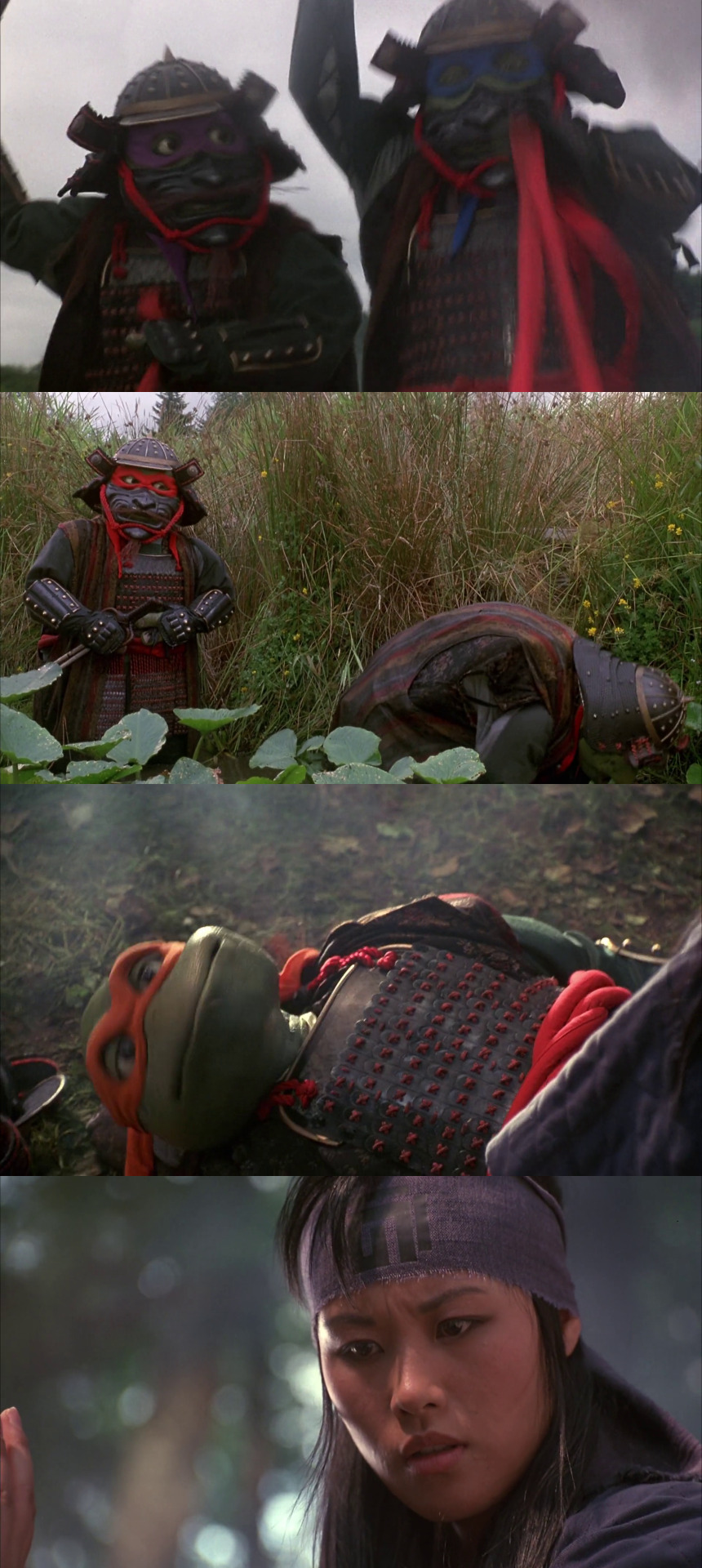
Arriving in ancient Japan, the Turtles find themselves in the place of a group of Honor Guards on horseback in the middle of a battle, struggling to find their bearings and ultimately landing in a ditch. Along the way Michaelangelo, wielding the scepter, is separated from the group. Mistaken first for being one of Norinaga’s men and then for a kappa, Mikey is knocked out and recovered by Princess Mitsu, who's leading the fight against Norinaga and Walker. She orders that Michaelangelo be carted off to recover in the village.

Norinaga boasts to Walker about the superiority of his Honor Guard to any weapon and becomes enraged upon learning that they’ve vanished, alongside the sceptre. Meanwhile Leo, Donnie and Raph infiltrate the palace. After freeing April from her cage, the reunited group escape via a chute that ejects them out the side of the castle into another ditch outside.

As the children of the village spot Michaelangelo without his helmet and are horrified by the sight of what they assume to be a kappa, the other Turtles and April adjust to their new surroundings, with Raphael noting how idyllic feudal Japan is versus the chaos and pollution of 1990s New York. The group are attacked by villagers assuming them to be aligned with Norinaga, and stop the fight by removing their masks to reveal their true identities. Mitsu puts two and two together and assumes they must be allies of Michaelangelo.

The Turtles are celebrated as heroes by the villagers, and are asked by Mitsu to stay and help them fight back against the daimyo (a term for feudal lords of the period, referring here to Norinaga). Our heroes stress that they need to reclaim the sceptre before their opportunity to return to their own time is gone, but until then they agree to assist.

Norinaga reveals the contents of his scroll to Walker, asking about the resemblance of the visitors to the four kappa depicted on it. The daimyo recalls how old priests told him his ancestors were defeated by these demons, who he believes have returned to confront him: to stop them, he agrees to Walker’s earlier offer, now willing to provide him with silver and silk in exchange for guns. Walker has upped his price due to the severity of the situation, now insistent on being provided with gold for his goods, angering the feudal lord.

The Turtles scour the area on horseback in search of the sceptre, but without success. Later, they inform a mortified April of their new plan, which involves building an entirely new sceptre. This task won’t be handled by Donatello, but instead by a local blacksmith. In the downtime that follows, the Turtles grow closer to the villagers, with Michaelangelo working alongside a cook in an unsuccessful attempt to invent pizza while also developing an attraction to Mitsu. Meanwhile, Raphael forms a friendship with Yoshi, discouraging him from fighting other kids and teaching him the importance of controlling his temper.

Checking in with events in New York, we see Casey and Splinter attempt to calm an increasingly on-edge Kenshin, who demands to be given the sceptre so he can be reunited with Mitsu. Casey cooks up a distraction by switching on a nearby TV, the assembled time-travellers mesmerised by the sight of an ice hockey game being broadcast.
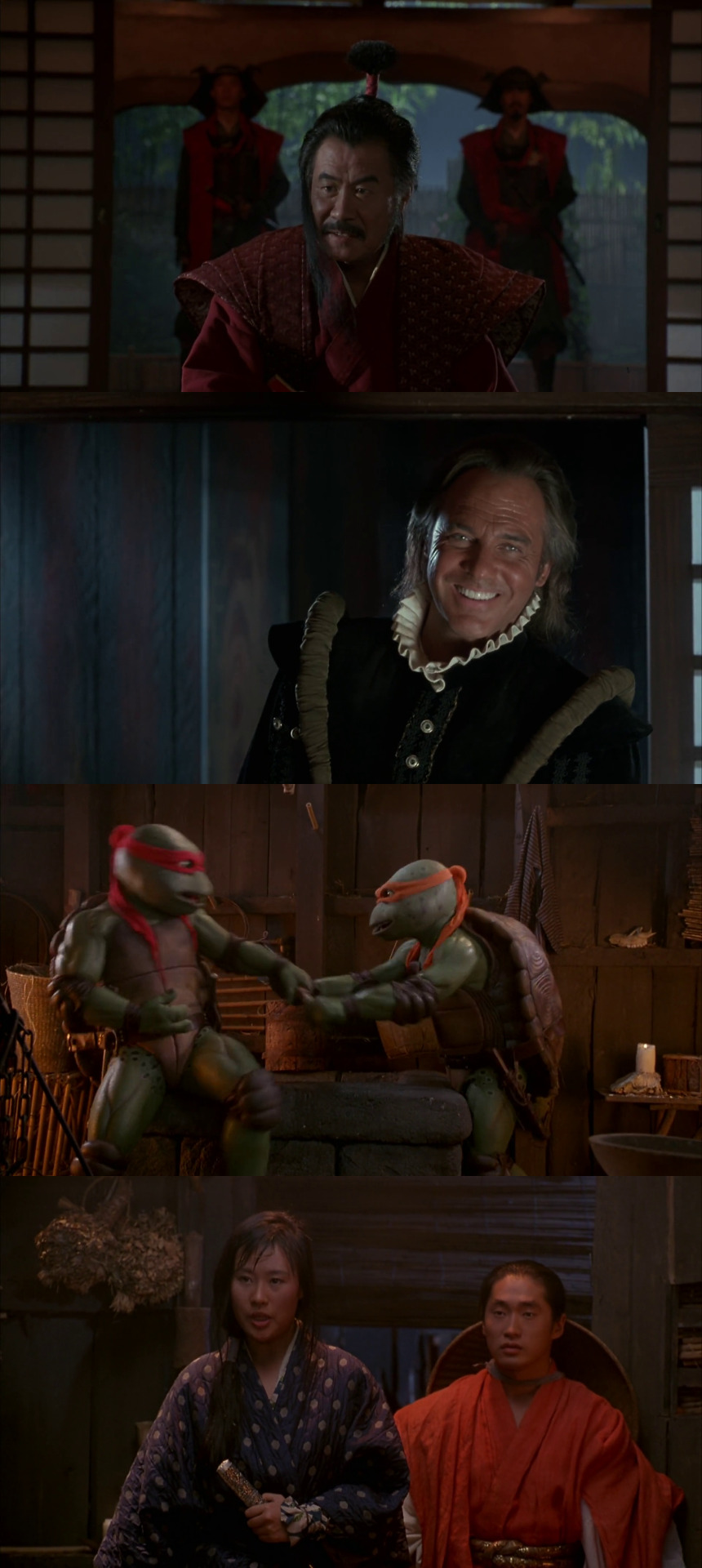
At Kumano Castle, Norinaga agrees to Walker’s terms, with the Englishman declaring that as the dungeon is becoming crowded his men will instead kill their enemies. Back in the village, the Turtles assemble around the new makeshift sceptre, but while arguing amongst themselves manage to drop the fragile item, causing it to shatter. Now left with no time to construct another before their window to return to the future closes, the Turtles are informed by Mitsu that Norinaga’s men will arrive in the morning, now heavily armed.
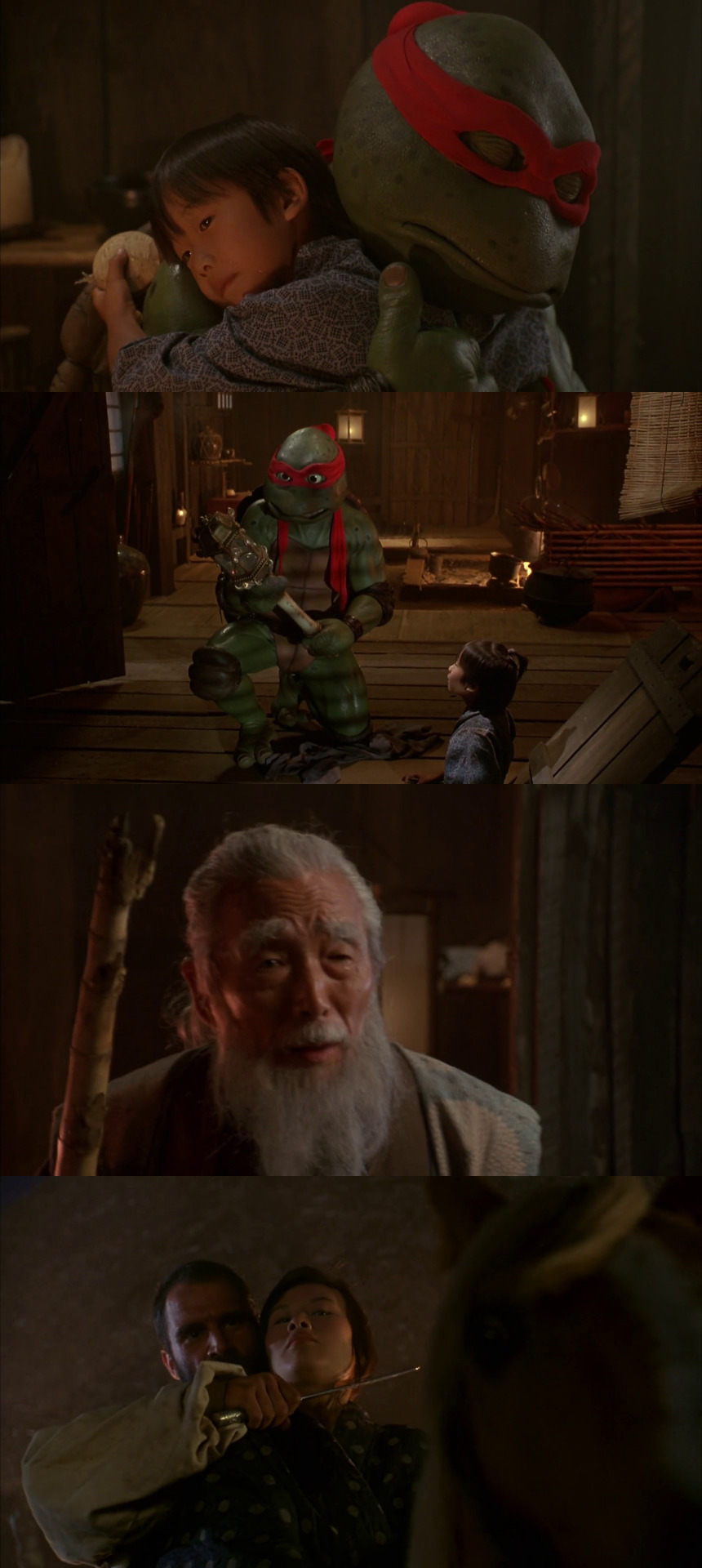
Raphael checks in with Yoshi, offering him a gift of a yo-yo. The youngster is burdened by the knowledge that tomorrow the Turtles could die in battle but is assured that everything will be alright. To prevent Raph from being lost in the oncoming clash, Yoshi offers his friend an item he recovered in the forest: the original scepter. It dawns on the Turtles that Mitsu ordered it to be stashed under their home to deter them from leaving, placing them in a position where they’d have to stay and help defend the village. Yoshi’s grandfather reveals he was the one who stashed the sceptre, not Mitsu. Before they can patch things up, the Princess is captured by an ex-member of Walker’s crew named Whit (played by Elias Koteas in a dual role in addition to Casey), who challenges the Turtles to bring Kenshin to the castle in exchange for her return.

Mitsu is offered up to Norinaga and accused of stealing the daimyo’s son. She counters by declaring Kenshin is “on a magic journey” and can only be brought back using the sceptre, which she announces is in Walker’s possession. The Englishman denies this is the case, and is allowed to leave. Later, he meets up with Whit, who accuses him of having kept the knowledge of the contents of the scroll a secret.

The Turtles infiltrate the castle for a second time and free Mitsu, before leaving again intent on meeting up with April. Along the way, the team discover the scroll prior to being confronted by Norinaga. The feudal lord is about to finish off the Turtles himself until Mitsu intervenes, with Michaelangelo making the save to stop her being hurt. Mikey is cut in the fight, a sign that Norinaga takes as confirmation the Turtles aren’t demons after all, but rather mere mortals.

Our heroes take on Norinaga’s men, ultimately emerging victorious. The green teens watch as the damiyo makes a bungled attempt to escape on horseback. He soon finds himself face to face with Leonardo and asks to be finished off. Rather than killing his enemy, Leo cuts off a portion of his hair before trapping him under an enormous bell. Still more challenges emerge for the Turtles as Walker has captured April. She reunites with the team as they face the prospect of being assassinated by a crew of heavily armed Englishmen, to Whit’s horror.

Walker is psyched out by the Turtles, who goad him into shooting them himself, insistent that he won’t do it as he’s afraid of being haunted by demons down the line should he be the one pulling the trigger. Enraged, the villain fires a cannonball which Leonardo dodges by retracting his head. The sight of this shocks Walker and his men, providing the Turtles with an opportunity to disarm their enemies.

The Turtles split up to corner Walker, surrounding him on the roof of the castle. He tosses the sceptre, using the distraction as an opportunity to mount an escape while Michaelangelo narrowly manages to catch it, but a fireball launched via catapult by Whit destroys his rope, sending him plunging into the sea to his certain demise.

As Casey tries to round up the Honor Guards ahead of the time exchange – who have now ventured outside to enjoy the sights and sounds of New York, such as uh... the 1985 Italo-disco hit “Tarzan Boy” by Baltimora? - the Turtles begin to have disagreements about whether they even want to return to their own time at all, with Donatello and April missing their modern conveniences, while Raphael and Michaelangelo feel strongly about remaining in 1603. The situation becomes urgent as Kenshin’s patience runs out and he activates the sceptre ahead of the Honor Guards returning. Finally, the Turtles agree to go back, but Mikey is separated from the group in the moments before the teleport begins.
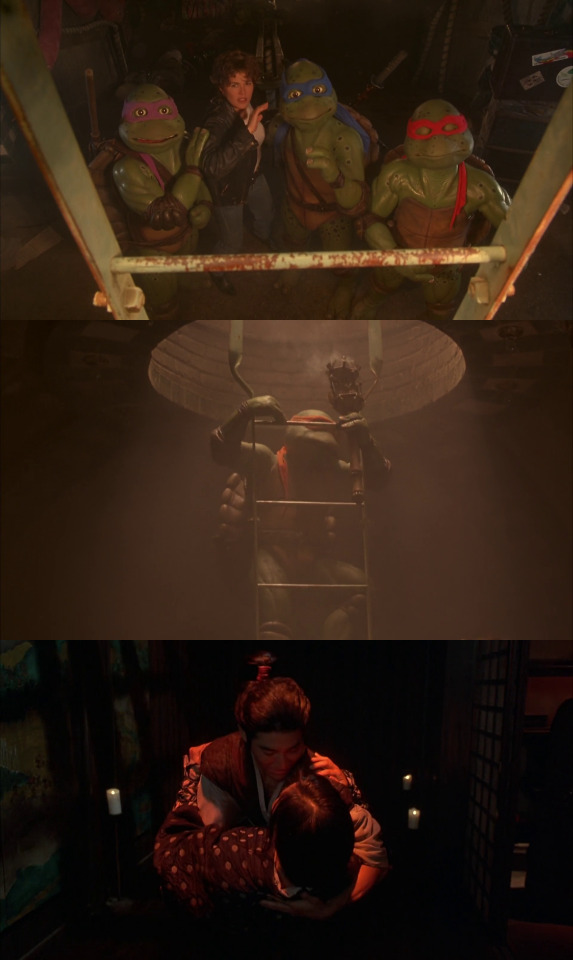
Arriving back in their home, the Turtles and Splinter are shocked to discover Michaelangelo didn’t return, the remaining member of the Honor Guard panicking and attempting to escape with the sceptre. Moments later he vanishes as well, Michaelangelo emerging to reunite with his brothers. Back in ancient Japan, Kenshin is reunited with Mitsu, the two embracing as mood lighting kicks in.

Michaelangelo is saddened by having had to make the difficult decision to leave Mitsu in the past, but is cheered up by Splinter placing a lampshade on his head and talking about the Elvis Presley movie “Blue Hawaii”, something Mikey himself did at the beginning of the movie. We end the same way we kicked things off as the Turtles perform another synchronised dance, this time to Technotronic and Ya Kid K’s “Rockin’ Over the Beat”.
While the first TMNT movie is widely celebrated and the perception of the second could be considered mixed, there’s no getting around the fact that the third is generally viewed as a stinker, one of several Turtles project from this period that nearly everyone now agrees to be a mistake alongside “We Wish You a Turtle Christmas”, “Turtle Tunes” and everything connected to the “Coming Out of Their Shells” tour. The simple fact of the matter is that a movie in which the Turtles interact with a bunch of new characters in ancient Japan wasn’t what the remaining kids who made up the bulk of TMNT’s fanbase wanted in 1993. It’s tempting to imagine a third Turtles film which throws everything and the kitchen sink in as a course correction after The Secret of the Ooze went out of its way to avoid introducing Rocksteady and Bebop: maybe this time we could have both mutants make their belated debut alongside Krang, the Technodrome, and a bunch of other recognisable elements drawn from the cartoon, the comics and even the toy line to win an increasingly jaded audience back. Such a film would have been an ambitious project that would have required an adequate budget and the craftsmanship of the Creature Shop, but what we got instead was an adventure with a relatively modest scope, created with the expectation that it would generate minimal returns, and it shows. It’s a bitter pill to swallow.
Okay, okay, but... hear me out. Yes, TMNT III is a disappointment, but I don’t think it’s entirely irredeemable. Like season seven of the cartoon, which aired later in the same year, this outing benefits from the fact that by 1993 the moral panic surrounding the Turtles had largely died down, parental groups and the press moving on to condemn Night Trap and Mortal Kombat instead. With no-one paying attention, this time around we get a film where the Turtles fight a lot, even if the use of their trademark weapons remains only nominal. I assume the production got away with this, in part, due to the action scenes representing historical violence. As a result at least we get to see the Turtles cut loose in a way that we maybe wouldn’t have had the film instead involved them fighting in their home turf of New York. (As with the first two outings, scenes involving the use of Michaelangelo’s nunchucks were cut for the initial UK release, and just like those earlier films the excised content was restored beginning with the DVD release in the early 2000s.)
There are other elements to appreciate about TMNT III beyond the emphasis on action. While the Turtles fire off one-liners and pop culture references here to the point where it can become grating, they’re also afforded moments to reflect and consider the differences of the era they’ve found themselves in to their own. Michaelangelo and Raphael’s arcs, in which they form connections with Mitsu and Yoshi respectively, allow both to demonstrate their ongoing personal growth; there’s a sense that both return to New York with a newfound maturity they didn’t have when they left.

In the Turtlethon entries for the first and second movies I neglected to mention that both received comic adaptations, published by Archie. The same is true again here, the comic version of TMNT III belatedly published in November 1993, closer to the film’s arrival on home video than it was to its cinematic run. Dean Clarrain and Chris Allan from the then-ongoing TMNT Adventures series adapted the story for print and did an incredible job: in fact, unless you’re particularly hung up on experiencing Turtles III as a movie, I’d go so far as to say you should just read the Archie version instead. The shoddy Turtle designs that encumber the story on celluloid here are transformed into wonderful, engaging characters, and their quips are by necessity pared down to fit into sixty pages. Writing this entry would have been a far greater chore for me if the Archie adaptation didn’t exist to provide me with a different perspective on it.
Well readers, it’s come to this. Together, over the last two years, we’ve meticulously dissected three films and a staggering 184 animated episodes of Teenage Mutant Ninja Turtles, reflecting on the highs, the lows, and the many moments that were downright inexplicable. Now, a mere eight episodes remain. We’ll start checking them off next time, as season ten commences with “The Return of Dregg”.
#Teenage Mutant Ninja Turtles#TMNT#Ninja Turtles#Turtlethon#1993#TMNT III#TMNT Casey Jones#Casey Jones TMNT#Turtlethon Extra Slices#90s films#1990s films
2 notes
·
View notes
Text
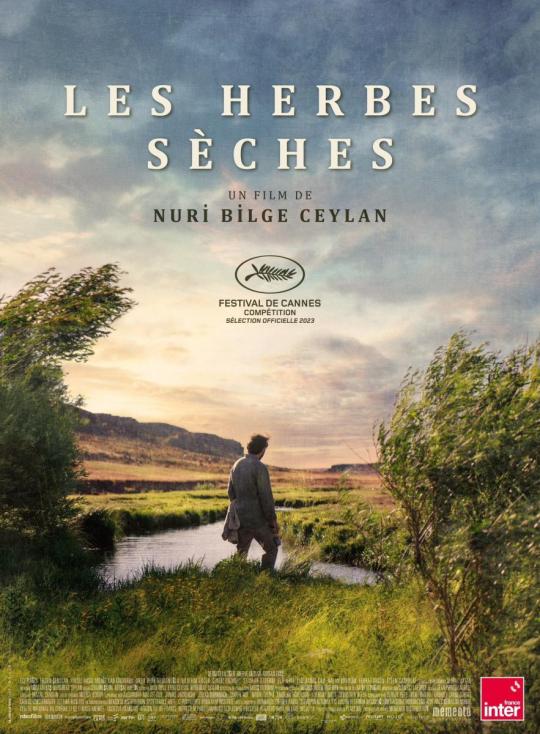
A todos, boa noite!
Hoje convido vocês a visitarem Os Filmes do Kacic, para conferir minha nova crítica sobre mais esta obra-prima do genial diretor turco Nuri Bilge Ceylan, um dos destaques do Festival de Cannes deste ano. Imperdível!
Crítica: ABOUT DRY GRASSES (KURU OTLAR ÜSTÜNE/LES HERBES SÈCHES) | 2023
🎬🎞🎥📽📺
#movies#cinema#filmes#geek#popculture#nerd#osfilmesdokacic#review#drama#cannes 2023#cannes#2023#nuri bilge ceylan#critica#movie review#about dry grasses#kuru otlar üstüne#las herbes sèches#critica about dry grasses#about dry grasses review
6 notes
·
View notes
Text
Ashes: A Gem Of Turkish Cinema On Netflix That Deserves Your Attention
Sabrina Santos
Turkish narratives have been gaining an increasingly prominent place in the hearts of film and series aficionados, consolidating themselves as one of the hidden treasures in Netflix's vast catalog. Among these gems, “Ashes” emerges, a Turkish drama that transcends conventional barriers to offer a deeply immersive and moving cinematic experience. If you are looking for a work that combines drama, passion and a subtle touch of romance, “Ashes” is the perfect choice.Alongside Funda Eryigit, the cast of “Ashes” is adorned with exceptional talents, such as Alperen Duymaz, known for his performances in “The Last Summer��� and “EGO”, and Mehmet Günsür. These actors bring to life complex, multifaceted characters, each contributing to the rich tapestry of emotions and tensions that permeate the film.The direction of “Ashes” skillfully navigates a narrative full of intense dramatic moments, surprising twists and scenes that challenge our understanding of the border between the real and the imaginary. The film stands out not only for its captivating story, but also for the way it explores universal themes through a unique prism, offering a reflection on love, loss and the incessant search for truth.“Ashes” is, without a doubt, a masterpiece of Turkish cinema that deserves to be discovered. Its gripping plot, combined with powerful performances and meticulous direction, make this film a worthy addition to the Netflix catalog. So if you're looking for a cinematic experience that will keep you glued to the screen from start to finish, don't hesitate to explore the rich narrative of “Ashes”. This film not only entertains, but also provokes deep reflection, solidifying its place as an unmissable work for lovers of quality cinema.
.
Kül: Netflix'te Türk Sinemasının İlginizi Çekecek Bir Cevheri
Türk anlatıları film ve dizi meraklılarının gönlünde giderek daha önemli bir yer ediniyor ve Netflix'in geniş kataloğundaki gizli hazinelerden biri olarak yerini sağlamlaştırıyor. Bu mücevherlerin arasında, son derece sürükleyici ve etkileyici bir sinema deneyimi sunmak için geleneksel engelleri aşan bir Türk draması olan “Kül” ortaya çıkıyor. Dramayı, tutkuyu ve ince bir romantizm dokunuşunu birleştiren bir çalışma arıyorsanız, “Kül” mükemmel bir seçimdir.Funda Eryiğit'in yanı sıra “Kül”in kadrosunu, “Son Yaz” ve “EGO” dizilerindeki performanslarıyla tanınan Alperen Duymaz ve “Tapınağın Sırrı” ile taninan Mehmet Günsür gibi olağanüstü yetenekler besliyor. Bu aktörler, her biri filme nüfuz eden zengin duygu ve gerilim dokusuna katkıda bulunan karmaşık, çok yönlü karakterlere hayat veriyor."Külun yönetmeni, yoğun dramatik anlarla, şaşırtıcı gelişmelerle ve gerçek ile hayal arasındaki sınıra dair anlayışımızı zorlayan sahnelerle dolu bir anlatıyı ustaca yönlendiriyor. Film sadece büyüleyici hikayesiyle değil, aynı zamanda evrensel temaları benzersiz bir prizmadan keşfetme biçimiyle de öne çıkıyor; aşk, kayıp ve bitmek bilmeyen hakikat arayışı üzerine bir yansıma sunuyor.Kül şüphesiz Türk sinemasının keşfedilmeyi hak eden bir başyapıtıdır. Güçlü performanslar ve özenli yönetmenlikle birleşen sürükleyici olay örgüsü, bu filmi Netflix kataloğuna değerli bir katkı haline getiriyor. Dolayısıyla sizi baştan sona ekrana kilitleyecek bir sinema deneyimi arıyorsanız Kül`un zengin anlatımını keşfetmekten çekinmeyin. Bu film sadece eğlendirmekle kalmıyor, aynı zamanda derinlemesine düşünmeyi de teşvik ediyor ve kaliteli sinema tutkunları için kaçırılmayacak bir eser olarak yerini sağlamlaştırıyor.
0 notes
Text
"Il fiore di Farahnaz", il libro di Yaprak Oz, premiato nel 2019 come miglior giallo turco dell’anno
“Il fiore di Farahnaz” è in distribuzione da novembre 2023, edito da Edizioni le Assassine nella collana “Oltreconfine”, tradotto da Nicola Verderame.
Siamo negli anni Settanta e la Turchia è scossa da profonde difficoltà economiche e sociali, tuttavia a Kilic, zona residenziale, dove vivono ingegneri e medici in servizio nel complesso minerario adiacente alla città di Zonguldak sulla costa del Mar Nero, la vita scorre tranquilla e spensierata, tra serate al cinema, partite a canasta, balli e cene. La piccola comunità di funzionari è infatti molto unita e i rapporti di vicinato sono improntati alla massima solidarietà fino a quando la moglie del direttore degli impianti minerari non viene trovata morta. L’omicidio della giovane donna viene attribuito al pazzo del paese, tuttavia Yildiz, moglie di uno degli ingegneri, divoratrice di gialli e sarta per passione, non si accontenta di questa soluzione di comodo. Da acuta osservatrice, accumula indizi che la portano a conclusioni ben diverse. Ma la protagonista del romanzo avvince anche per il suo modo di essere: grazie a lei hanno voce tutte le donne del quartiere; ognuna di loro racconta i propri sentimenti ed emozioni: l’angoscia di un figlio che non arriva, la gioia di uno che sta arrivando, la tristezza di una madre che accompagna sua figlia non vedente nel verde dei boschi, fino alla rabbia di una donna che si è sempre sentita non voluta. “Voci di donne” diverse, che nel profondo si ricollegano a una voglia incessante di essere buone madri, ma anche di essere ancora figlie.
Un giallo appassionante, capace non solo di raccontare il vero volto del male, ma di indagarne da vicino le profonde motivazioni di chi sceglie di macchiarsi di sangue per giungere alle vette più alte. Un testo premiato nel 2019, come miglior romanzo giallo dell’anno, in grado di offrire una fotografia precisa di una cittadina turca prima del colpo di Stato del 1980.
Info biografiche
YAPRAK ÖZ è nata nel 1973. Ha frequentato il Collegio TED di Zonguldak Koleji e la facoltà di Cultura e Letteratura Americana presso l’Università di Istanbul. Ha pubblicato poesie, racconti e saggi su numerose riviste e antologie in Turchia e all’estero. Le sue poesie sono state tradotte in numerose lingue, tra cui inglese, greco e svedese. Fa parte dell’Unione degli Scrittori di Poliziesco di Turchia e del PEN International. Ha pubblicato cinque raccolte di poesia e otto romanzi, quattro dei quali hanno per protagonista Yıldız Alatan.
Link di vendita online:
https://edizionileassassine.it/prodotto/il-fiore-di-farahnaz/
Dettagli prodotto:
Editore: Edizioni Le Assassine
Genere: Giallo
Collana: Oltreconfine
Lingua: Italiano
Copertina flessibile: 344p
Read the full article
0 notes
Text

Nuri Bilge Ceylan: Başka Bir Yerde
Ritratti fotografici dell’artista turco Nuri Bilge Ceylan (1959), uno dei cineasti più autentici del cinema di oggi, in mostra ad Istanbul
0 notes
Text
Viaggio ad Istanbul, gioiello del Bosforo
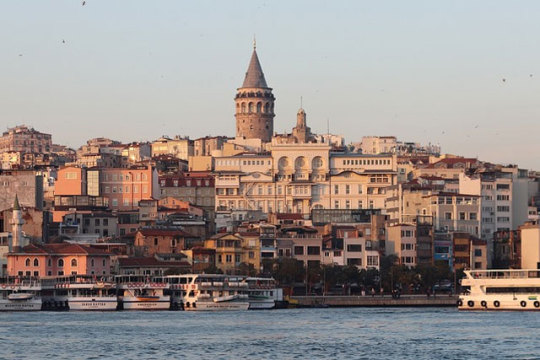
Stai pensando di organizzare un Viaggio ad Istanbul? Ottima scelta andare in una città dove l'Oriente incontra l'Occidente. Questo fatto si riflette nella sua cultura, storia, arte e architettura. È un crogiolo di culture, religioni e tradizioni.Istanbul è stata la capitale di tre imperi: bizantino, romano e ottomano. La sua ricca storia è evidente nell'architettura della città, come la Basilica di Santa Sofia, il Palazzo Topkapi e la Moschea Blu.La Basilica di Santa Sofia fu costruita nel VI secolo come chiesa e successivamente trasformata in moschea durante l'era ottomana. Ora funge da museo, a testimonianza del variegato passato di Istanbul.Il Palazzo Topkapi, un tempo residenza dei sultani ottomani, è oggi uno dei siti più visitati, con splendidi esempi di arte turco-islamica. Vi si trova calligrafia, ceramica e arti decorative.
Viaggio ad Istanbul, dove l'Europa incontra l'Asia
La Moschea Blu, nota anche come Moschea del Sultano Ahmed, è un'imponente struttura con sei minareti e un interno unico con piastrelle blu. È ancora usato come luogo di culto ed è noto per la sua caratteristica architettura islamica.La cucina di Istanbul è anche un riflesso della sua storia variegata. La cucina turca è una combinazione di influenze dell'Asia centrale, del Medio Oriente e del Mediterraneo. I piatti più popolari includono kebab, meze, baklava e delizie turche.I mercati di Istanbul, o bazar come è comunemente noto, sono un centro di attività. Il Grand Bazaar è uno dei mercati coperti più antichi e più grandi del mondo, con oltre 4.000 negozi che vendono di tutto. Puoi trovarci dall'oro alle spezie, dai tessuti alla ceramica.La città ha anche una vivace scena artistica. La Biennale di Istanbul, una mostra internazionale di arte contemporanea, si tiene ogni due anni e attira artisti e appassionati d'arte da tutto il mondo. Vi sono numerose gallerie, musei e spazi d'arte.
Istanbul: la città dei quattordici imperi
Il famoso Stretto del Bosforo di Istanbul, un corso d'acqua naturale che separa la parte europea e quella asiatica della città. E' una popolare attrazione turistica. I tour in barca offrono viste mozzafiato sulla città e su monumenti come la Torre della Vergine e il Palazzo Dolmabahçe.Sebbene Istanbul sia conosciuta per la sua storia antica, ha anche un lato moderno. La città ospita numerosi centri commerciali, cinema e luoghi di intrattenimento. Il centro commerciale Istinye Park e lo Zorlu Center, ad esempio, presentano marchi internazionali, boutique di lusso e ristoranti di lusso.Istanbul è una città che ha davvero qualcosa per tutti. La sua ricca storia, la diversità culturale e i servizi moderni ne fanno una destinazione turistica popolare. Sei interessato a esplorare monumenti antichi? A gustare la cucina turca? A provare l'intrattenimento moderno? Istanbul allora è la destinazione perfetta. Lo sapevi che Istanbul è l'unica città al mondo che sta su due continenti? Europa ed Asia.
Read the full article
#architettura#Bosforo#cibo#Cornod'Oro#cultura#deliziaturca#GranBazar#Istanbul#MoscheaBlu#PalazzoTopkapi#PiazzaTaksim#SantaSofia#storia#TorrediGalata#Turchia
0 notes
Text
Verissimo: nelle giornate di sabato e domenica tanti ospiti partendo da Giorgia, Nino D'Angelo ma anche Piero Chiambretti.
Verissimo: nelle giornate di sabato e domenica tanti ospiti partendo da Giorgia, Nino D'Angelo ma anche Piero Chiambretti.
Nelle due giornate del weekend si alterneranno diversi ospiti, infatti al sabato Silvia Toffanin accoglie Piero Chiambretti, in partenza su Canale 5 con un nuovissimo programma dal titolo “La tv dei 100 e uno”. A Verissimo, in esclusiva, l’attore turco Uğur Güneş, alias Yilmaz Akkaya, il protagonista della fortunata serie di Canale 5 “Terra amara”. Inoltre, in studio la lunga carriera di Franco Nero al cinema con il film “L’uomo che disegnò Dio”, il racconto di vita della cantante Syria, il percorso di Manuela Villa e il fascino dell’attrice Madalina Ghenea.
Per quanto riguarda domenica invece a Verissimo l'intervista a tutto tondo ad una delle voci più belle del panorama musicale italiano: Giorgia. In studio, con la sua umanità e sui oltre quarant’anni di carriera Nino D’Angelo. Infine, si racconteranno: Sandra Milo, icona senza tempo del cinema italiano, Anna Pettinelli e Paola Caruso, che parlerà del grave problema di salute che ha colpito mesi fa suo figlio Michele e di come stia oggi....
#notizie #news #breakingnews #cronaca #politica #eventi #sport #moda
Read the full article
0 notes
Text
Origem da Língua Japonesa

Origem da Língua Japonesa
Em 2010 a população do Japão se aproximava dos 127 milhões de pessoas e, no que tange ao seu idioma, trata-se de uma nação homogênea, com mais de 99% de sua população utilizando-se da mesma linguagem. Isso significa que a Língua Japonesa é a sexta mais falada no mundo. Entretanto, a língua é utilizada raramente fora do Japão. Origem da Língua Japonesa
Existem muitas teorias sobre a origem da Língua Japonesa. Um grande número de pesquisadores acredita que sintaticamente o idioma se aproxima das línguas Altaic como o turco e o mongol, além do já consenso que a sua sintaxe se assemelha com o coreano. Existem ainda algumas evidências que a sua morfologia e vocabulário sofreram influência pré-histórica das línguas malaio-polinésias do sul. Origem da Língua Japonesa
O sistema de escrita japonês veio do chinês, embora a língua falada pelos japoneses e chineses sejam completamente diferente. Após a escrita chinesa ter sido introduzida entre os séculos V e VI, ela foi acrescentada de dois alfabetos fonéticos (hiragana e katakana), que eram variações modificadas dos caracteres chineses.
Um grande número de dialetos locais ainda é utilizado. Enquanto o japonês padrão, baseado na fala dos habitantes de Tóquio, foi se expandindo gradativamente pelo país devido a influência das mídia como o rádio, a televisão e o cinema, os dialetos falados em Kyoto e Osaka, em particular, continuam se desenvolvendo e mantêm o seu prestígio. Origem da Língua Japonesa
Diferente de línguas européias como o inglês ou francês, cuja origem remonta a uma família lingüística definida (no caso, a Indo-Européia), a língua japonesa não tem uma origem determinada. Apesar da extensa pesquisa dos filólogos japoneses, não existe nenhuma evidência concreta o suficiente para ligar a língua japonesa a uma única família lingüística. Existem algumas teorias circulando na comunidade lingüística quanto à origem da língua japonesa.
A principal delas liga o japonês à família Altaica, da qual fazem parte o Turco e Coreano. A linguagem Altaica, falada na região da estepe Transcaspiana, supostamente foi levada ao Japão devido a uma migração maciça destes povos no século XX a.C., sendo considerado o clã Yayoi, imigrantes da região coreana, responsável pela introdução da língua nas ilhas japonesas. Existem ainda outras teorias que ressaltam a influência de outras línguas asiáticas na formação da língua japonesa, como as línguas do sudeste asiático (tibetano, vietnamita) e da Polinésia. A mais aceita das teorias é a híbrida que alude a influência das línguas austronésias, como o Malaio e outras línguas do Pacífico, na formação lexical da maioria dos termos japoneses. Com a introdução da cultura chinesa, a língua japonesa sofreu uma profunda alteração, posto que novos meios de pensamento e expressão também foram introduzidos. Apesar de a maioria das palavras japonesas derivarem-se do chinês (cerca de sessenta por cento), a gramática japonesa parece não ter se alterado muito neste processo.
Onde a Língua Japonesa Se Originou?
A Língua Japonesa se originou na região dos rios Amur e Ussuri, onde a antiga cultura Jomon habitava. A Língua Japonesa desenvolveu-se principalmente pela influência dos dialectos falados pelas tribos locais. Talvez o mais impactante fosse a contribuição da cultura chinesa, pois trouxe consigo muitas palavras auxiliares à língua japonês. Ao longo do tempo, esta mistura de vários dialectos gerou a língua moderna que conhecemos hoje.
Como a Língua Japonesa Evoluiu Por Séculos?
Desde seu início, a Língua Japonesa sofrera diversas alterações para chegar à sua forma moderna de hoje. Durante os séculos Yayoi e Kofun, vimos a introdução das prioridades linguísticas e da escritura kanjis. No período Heian, é conhecida como a "Era de Ouro" e expandiu-se drasticamente com novas palavras e frases vindas principalmente do chinês antigo. O japonês moderno surgiu séculos depois quando o jogo de regras gramaticais padronizado foi formalizado na última meia década do período Edo.
Quais Fatores Desenvolveram o Idioma Japonês?
Durante o período de desenvolvimento japonês, vários fatores contribuíram para o desenvolvimento da língua. A influência chinesa foi chave para o surgimento do idioma moderno japonês, especialmente durante a Idade Heian e concentrou-se principalmente na aquisição de sintaxe, vocabulário e frases. Além disso, os dialectos autoctones 'ainu' e 'ryukyuan', bem como as palavras europeias introduzidas mais tarde também foram importantes na formação da língua moderna.
Qual é o Papel dos Dialetos no Falar Japonês Moderno?
Os dialectos japoneses desempenham um papel fundamental na língua moderna. Quando os dialectos são usados oralmente, eles tendem a ser vistos como sinais de familiaridade ou relacionamento próximo entre falantes. Isso permite que as pessoas transmitam sentimentos mais ricos ou humor em algumas situações sociais. No entanto, em grandes cidades ou organizações governamentais, o padrão normativo de tokêse prevalece geralmente sobre qualquer outro dialeto regional.
Como Aprender a Língua Japonesa Hoje em Dia?
Aprender a língua japonesa pode ser um processo desafiador, pois é muito diferente de quase todas as línguas europeias. Existem três sistemas principais para aprender kanji, palavras e frases: memória, compreensão e escrita. O primeiro passo para começar nessa jornada é encontrar material adequado para aprender com base em seu nível atual. Depois disso, você precisa estabelecer metas realistas definindo o que quer ganhar a longo e curto prazos. Isso pode incluir adicionar palavras à sua rotina diária; estudando a gramática japonesa básica; assistindo filmes e programas de televisão locais; praticando os dialetos; e expondo-se repetidamente à língua falada por fontes autênticas.
France - USA - Brasil - Viagem
Read the full article
0 notes
Photo
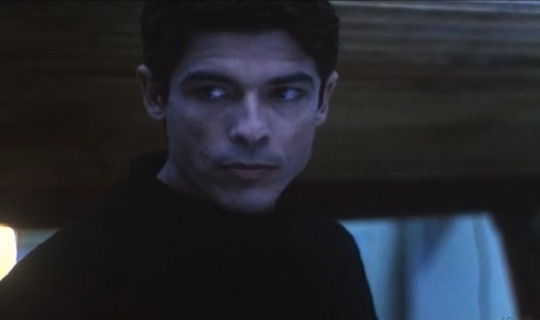


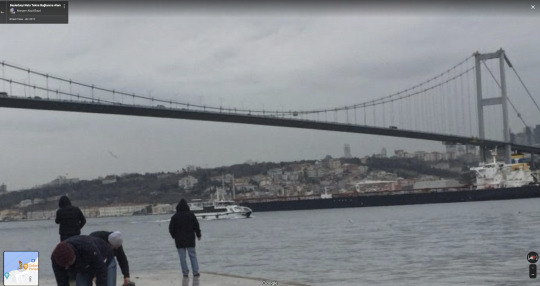
Hamam / Steam: The Turkish Bath
Ferzan Özpetek. 1997
Bridge
Beylerbeyi Nato Tekne Bağlanma Alanı, Beylerbeyi, 34676 Üsküdar/İstanbul, Turkey
See in map
See in imdb
#ferzan özpetek#hamam#il bagno turco#steam#the turkish bath#istambul#turkey#alessandro gassmann#mehmet günsür#beylerbeyi#iron bridge#bosforo#movie#cinema#film#location#google maps#street view#1997
5 notes
·
View notes
Text
oggi, 17 aprile, allo studio campo boario (roma): "una percentuale davvero irrisoria", di nicola de simone; e i quattro video "prologue" dell'ensemble index (= ariano, d'agostino, giovenale + venitucci)

View On WordPress
#Alberto D&039;Amico#Antonio Francesco Perozzi#asemic#Bruno Lo Turco#corto#experimental video#Incontri ravvicinati tra arte e cinema#index#Luca Venitucci#Marco Ariano#Marco Giovenale#Massimo Arduini#Nicola De Simone#Pietro D&039;Agostino#Roberta Melasecca#scrittura asemica#scritture di ricerca#Studio Campo Boario#Tra arte e cinema#video
0 notes
Text
Turtlethon Extra Slices: “Teenage Mutant Ninja Turtles II: The Secret of the Ooze”

US Release Date: March 22, 1991
UK Release Date: August 9, 1991
Teenage Mutant Ninja Turtles II: The Secret of the Ooze is the follow-up to the hugely successful first live-action Turtles movie, released in the US through New Line Cinema. Much has changed in the year since the original TMNT film made its debut, coinciding with Turtlemania reaching its peak. Its director, Steve Barron, reportedly bowed out during post-production, the project heading in a different direction than he had originally envisioned. Judith Hoag, who played April O’Neil, was also unhappy, feeling that the finished product was too violent and that the more spiritual elements of the original story – I’m guessing this would have related to the mystical connection between the Turtles and Splinter ultimately confined to the campfire scene – were left on the cutting room floor.
As discussed in the entry for the first movie, the darkness present in that initial cinematic Turtles outing generated some consternation, not only from pundits and parental groups but from certain parties concerned with the business side of TMNT, most notably action figure licensee Playmates. What’s remarkable is that the final cut had already been watered down from what Barron had envisioned: most notably, the scene where Shredder’s right-hand man Tatsu took out his frustrations on one of the Foot Clan hoodlums was intended to have been considerably more violent than it ended up being. The pencilled-in punk rock soundtrack was swapped out for more commercially palatable hip-hop and new jack swing material that would shift plenty of units when the inevitable cash-in “Music from the Motion Picture” CD was released. These considerations would go on to dramatically impact the creative direction of the sequel: if there was so much money to be made in a gritty Turtles movie, so the thinking went, surely a brighter, agreeable one would draw in an even bigger audience.
The clock was also ticking. It was apparent to all involved that the dizzying levels of success the Turtles had achieved would be fleeting; inevitably kids would move on to whatever the next hot new trend would be before too long, and so there was a need to rush the second movie into production almost immediately after the first proved to be a hit. Barron was replaced by Michael Pressman, whose work in the years immediately prior had mostly been in the made-for-TV-movie field; meanwhile Paige Turco would be drafted in to fill the role of April. External factors would also lead to the Turtle whose original voice actor had the highest profile needing to be re-cast: Corey Feldman was dealing with addiction issues during the production of TMNT II, and so the decision was made to replace him with Donatello’s in-suit actor Leif Tilden for this chapter of the trilogy.







We open with shots of various New Yorkers enjoying pizza before being introduced to Roy’s, where delivery boy Keno (Ernie Reyes, Jr.) is tasked with making yet another visit to the home of April O’Neil. Upon arriving, he spots a robbery in progress at a neighbouring shopping complex. Keno confronts the crooks and uses his martial arts prowess to take out a few of them, but soon finds he’s bitten off more than he can chew, their numbers overwhelming. The Turtles intervene, having spotted the raid in-progress from nearby, and so an extended fight scene unfolds.
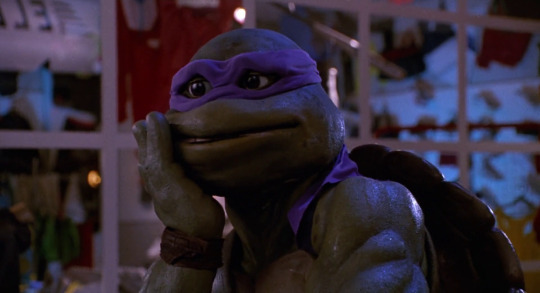

It’s immediately apparent how much things have changed from the first movie, where in their initial appearance the Turtles were barely glimpsed at all, acting quickly under cover of darkness to avoid being seen. Here they show no such restraint, yukking it up and engaging in slapstick reminiscent of the 1987 cartoon at its worst as they use toys and other items dotted around the stores they wander into to defeat their opponents. (I’m reminded particularly of the atrocious fight in the baby store from “Four Turtles and a Baby”, one of the lowest points of the entire series.) Jim Henson’s Creature Workshop has continued to develop the technology used in bringing the Turtles to life, something on show here: from the outset we can see that the team are now more wide-eyed, expressive and capable of pulling off cartoony expressions than before. As a result, they more closely resemble their animated counterparts from the Fred Wolf series.


A particular sequence of note involves Michaelangelo wielding sausages as makeshift nunchucks; this was removed from the initial UK release of the movie on the instruction of the then-director of the British Board of Film Classification, James Ferman, who was unwilling to recognise any distinction between the improvised weapons and the real thing. From the Region 2 DVD release in 2002 onward this scene was restored, the twin moral panics of the Turtles and nunchucks corrupting the youth both by then only vague memories which had long since receded out of the public consciousness.
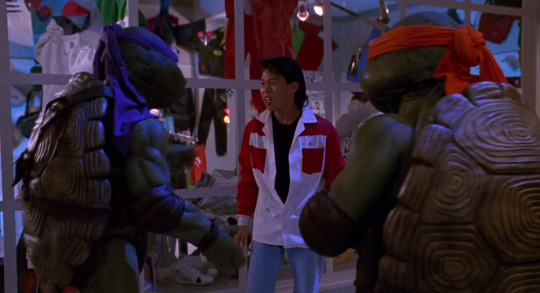
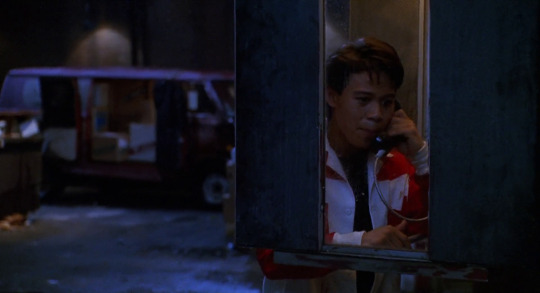
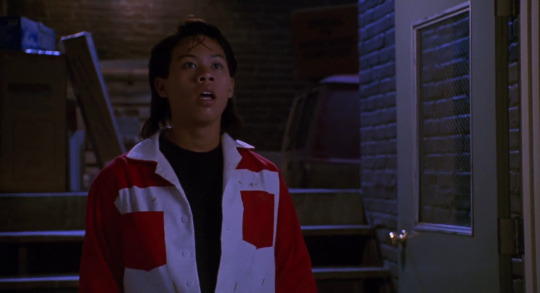
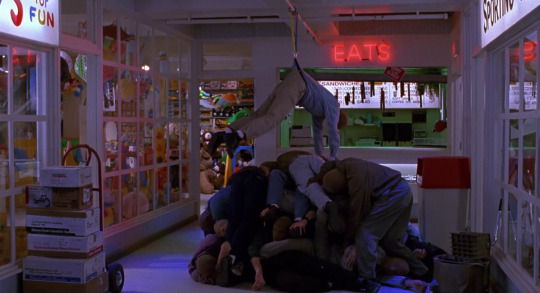
Keno is instructed by the Turtles to call the police and request someone pick up the defeated robbers; by the time he returns not only have the crooks all been tied up, but his pizzas have been taken, a wad of cash left in their place.

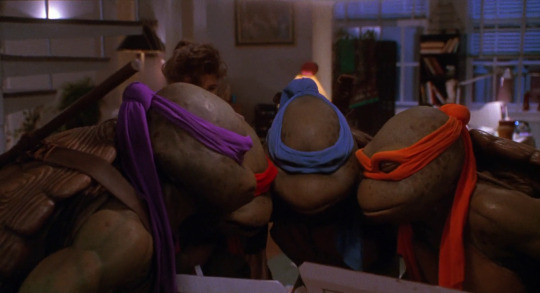
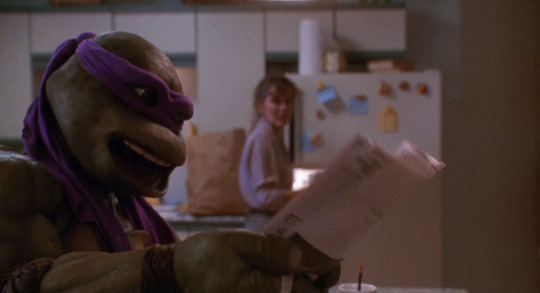
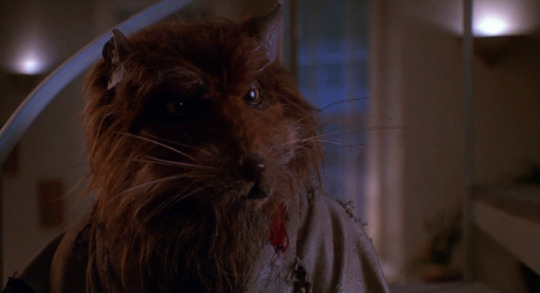
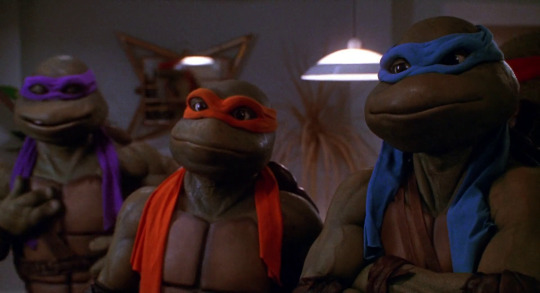
April returns to her fancy new apartment at the same time the Turtles sneak in the window. The group yuk it up some more while also discussing the defeat of the Shredder at the end of the previous movie and their need to find a new home, given that the Foot Clan learned of the existence of their old lair. Splinter soon emerges and reminds his sons of the importance of remaining invisible as ninjas. He goes on to add that thoughts of Shredder should remain buried in the past.

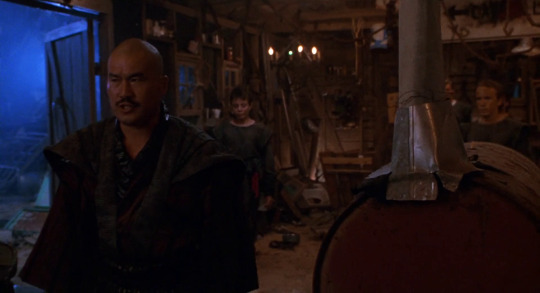
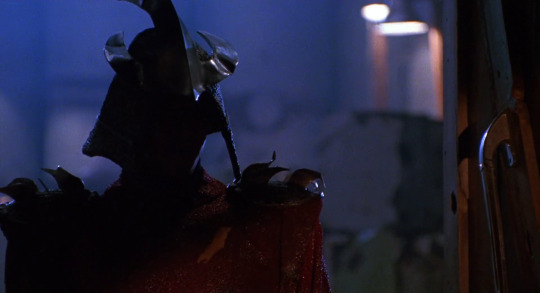
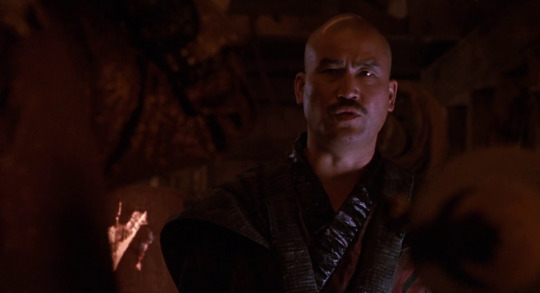
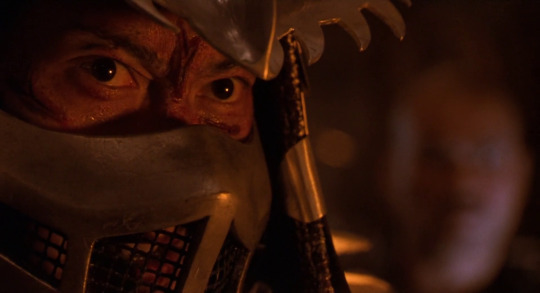
At a garbage dump, a hand and a familiar bladed gauntlet are seen emerging from the debris. By sheer coincidence, this site was also selected as the fall-back location for the Foot Clan, its remaining members seen arguing among themselves in a hideout nearby. Tatsu again flies into a rage, declaring himself the group’s new leader, but this proves to be short-lived: Shredder returns, remarkably resilient for someone who up until now was thought to have been crushed to death by a garbage truck. He declares his intentions to target April as a means of getting back at the Turtles and Splinter, the only thing he now cares about.
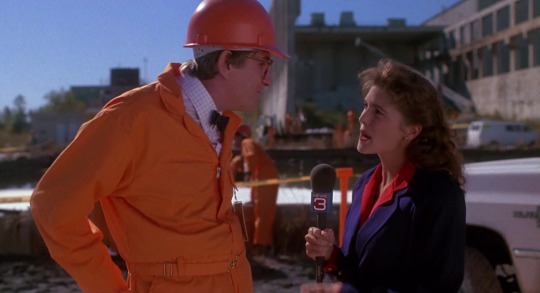





Reporting for Channel 3 News, April chats with a spokesperson for Techno-Global Research Industries (TGRI), Professor Jordan Perry, at the site of a contaminated area the firm is now working to clean up. Perry says little of any substance in the piece, which is watched on TV by the Turtles and Splinter. Freddy, a member of April’s news crew, sneaks behind a taped-off area once filming is over and discovers giant dandelions, a tell-tale sign that something has occurred with a huge environmental impact. Later, Perry informs one of TGRI’s employees that all the mutated dandelions must be removed, explaining that allowing the press to film there was the best way to ensure no-one suspected anything unusual was taking place.


Unbeknownst to April, Freddy, the rookie on her crew who discovered the giant dandelion, is an undercover member of the Foot. He takes his findings back to Shredder. Now clad in snazzy new purple attire, Shreds orders Tatsu to prepare his troops for an upcoming mission.





Splinter entered an extended period of meditation after watching April’s report, and upon her return home summons her along with the Turtles to the roof of the apartment building. There, he reveals that he kept the cannister that contained the ooze which, fifteen years earlier, transformed him along with the Turtles into their current forms; when re-assembled, the initials printed on it read “TGRI”. Now, he tells his students, the truth about their past has re-surfaced, and with it a potential danger to the people of the city.
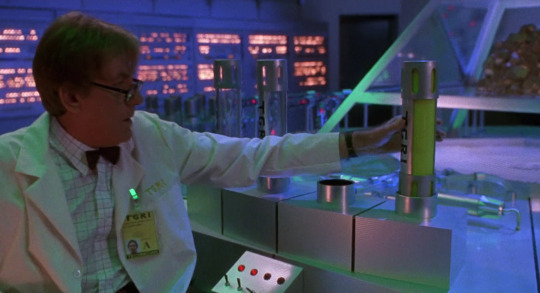

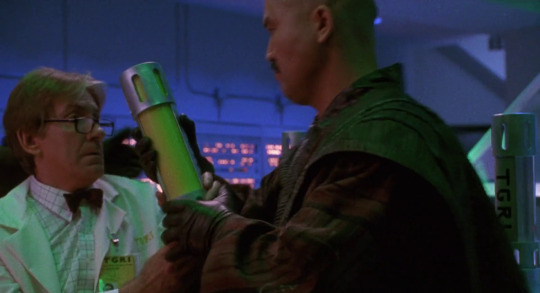




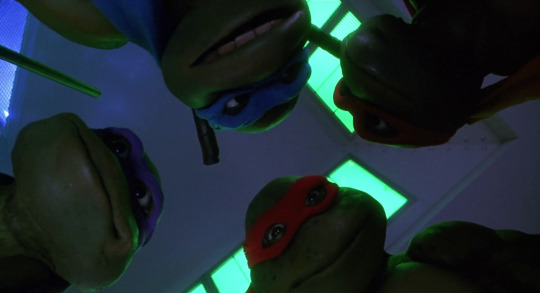
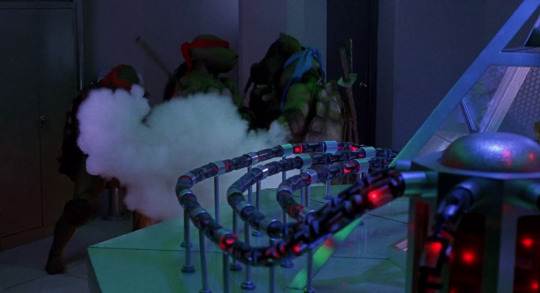
Professor Perry is seen in a lab on TGRI’s premises, examining records that show only one cannister of the type possessed by Splinter remains, the rest marked as “disposed”. He’s soon taken captive by Tatsu and a group of Foot ninjas. Later, the Turtles sneak into the building and examine the records on Perry’s computer, only to be confronted by Tatsu and his men, who goad their enemies with the prospect of claiming the last remaining full cannister. A fight breaks out which initially seems promising but again the Turtles are limited to performing slapstick routines with the items scattered around them, largely forbidden from using their weapons. Things peter out with Tatsu hurling a smoke bomb at the green teens, allowing both him and his men to escape.


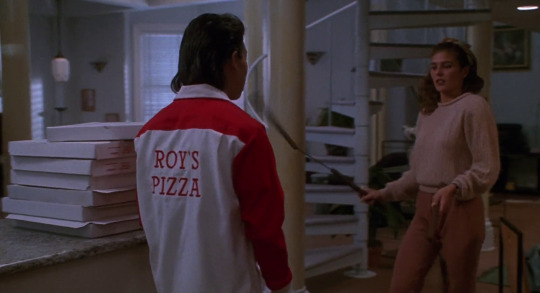

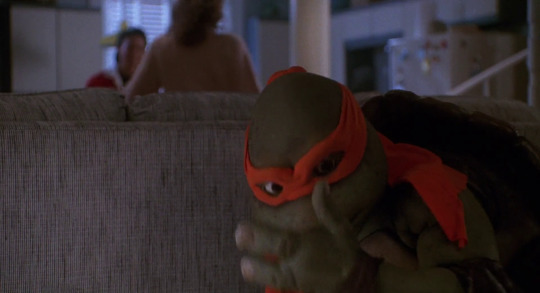
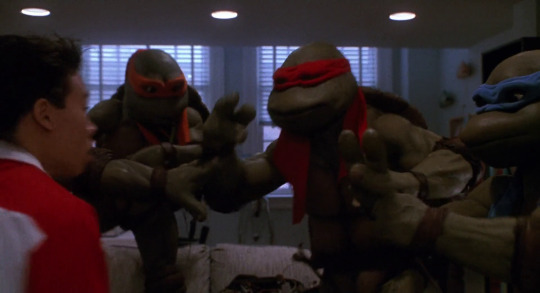

Later, the Turtles begin preparing to move out of April’s apartment when Keno wanders in, suggesting that given the staggering number of pizzas she orders she may as well take another from an unsuccessful delivery intended for a neighbour. April struggles to make excuses after the delivery boy spots Michaelangelo’s nunchucks sitting on the counter, attempting in vain to demonstrate her proficiency with the weapons in a sequence that I’m sure severely traumatised James Ferman. None of this convinces Keno, who spots the Turtles hiding in plain sight and forces them to come out into the open. After learning of their history, he reveals his own knowledge of the Foot and their recruitment activities, suggesting he could work his way into the operation on their behalf, an idea endorsed by Raphael but swiftly shot down by Leonardo and Splinter.

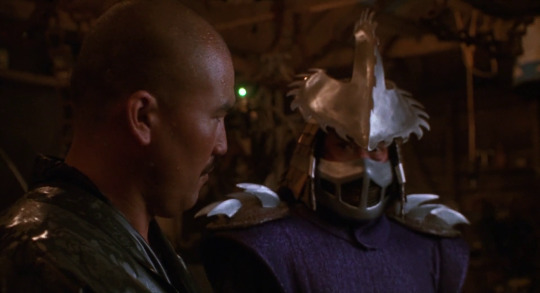


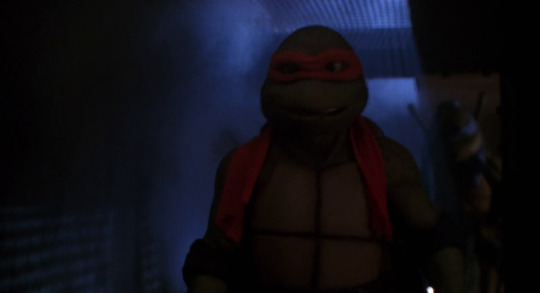
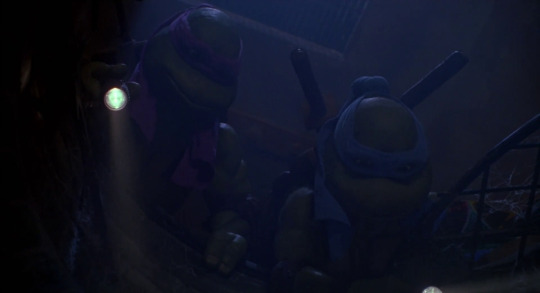

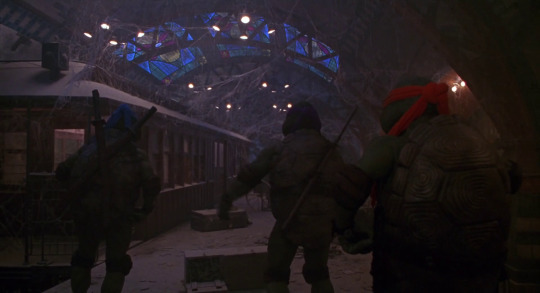

Under duress from both Shredder and Tatsu, the kidnapped Professor Perry begins the procedure of using the remaining cannister of ooze to transform the two most vicious animals the villains could find. Meanwhile the Turtles say their goodbyes to April, heading underground in search of their new home. Raphael’s temper (and his on-again, off-again tension with Leonardo) flares up again as he refuses to participate in this exercise, stomping off to find a better use of his time. Moments later, Michaelangelo unwittingly stumbles upon an abandoned subway station, complete with unused train carriages, and the group begin to discuss the possibility that this could serve as their new residence.


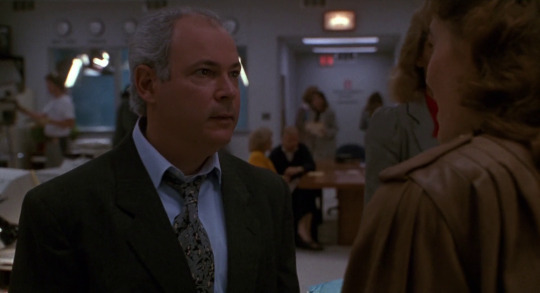
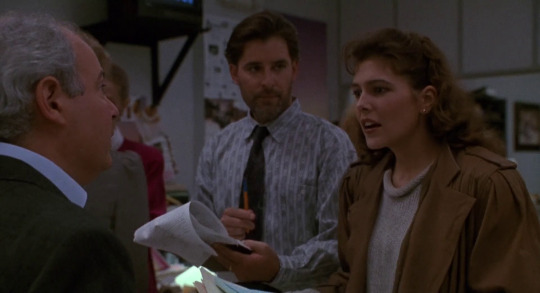
At the Foot’s hideout, Shredder demands from Perry that the mutants be ready for battle with the Turtles as soon as possible, noting the failure of both his ninjas and himself in defeating the team, and that the next battle will be “freak against freak”. At Channel 3, April is pressured by a station manager called Phil – Charles from the first film is never mentioned – to do a more ratings-friendly story on swimsuits rather than pursue her investigation of TGRI.

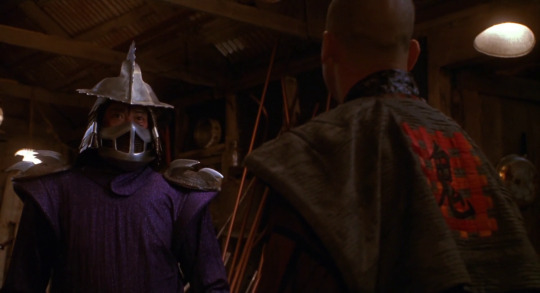



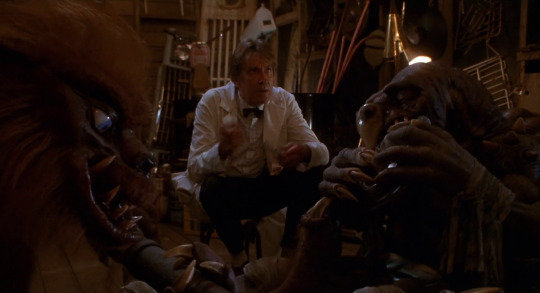
Back to Shredder again. Having tired of waiting around, he demands Tatsu remove the bar keeping the two new mutants in their makeshift junk cell, a grey hand and a brown furry one occasionally poking out. Dutifully the underling does so, and the beasts are revealed: snapping turtle Tokka and wolf Rahzar, though neither are named at this point. After Shredder declares himself to be their master, the mutants mistakenly think him to be their “mama”. Both are, to the great frustration of Shredder, mere infants; it’s explained to him by Perry that this should have been obvious from the outset. Like the Ninja Turtles, who in this continuity grew from infants to adolescents over the course of fifteen years, Tokka and Rahzar will learn and develop over time, but for now are far from the fearsome warriors the masked villain had envisioned. Shredder orders them to be terminated, but Perry pleads that there must be a use for them, demonstrating that their relative strength can make them useful in carrying out tasks around the hideout.

It’s remarkable that we’re forty minutes into TMNT II and Shredder, an intimidating and grandiose figure in the first movie, is following the exact same trajectory that his animated counterpart did back in season two of the 1987 show, already becoming an ineffectual schmuck who clearly has no clue what he’s doing. With that observation out of the way, we now return to the movie, already in progress.
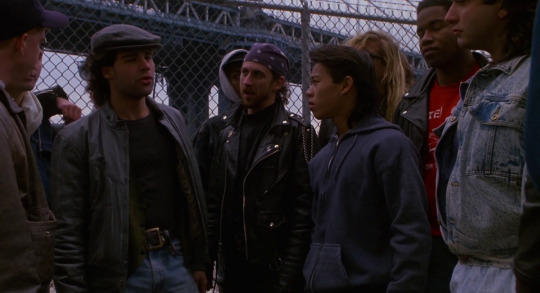










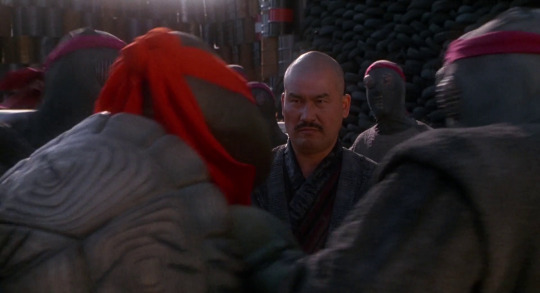

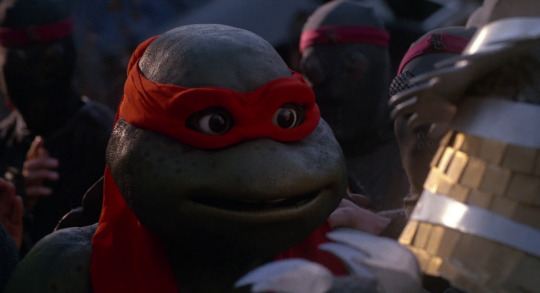
Raphael helps Keno to infiltrate the Foot’s operation as per his earlier suggestion, the delivery boy impressing a recruiter in a combat exercise. As a further test, Keno is required to remove a set of bells from a mannequin in a cloud of smoke; after doing so with unseen help from his Turtle ally he becomes a full-fledged member of the group, later reuniting with Raph in the scrapyard hideout. It doesn’t take long before both are spotted by Tatsu. Raphael orders Keno to flee, soon finding himself face-to-face with Shredder.


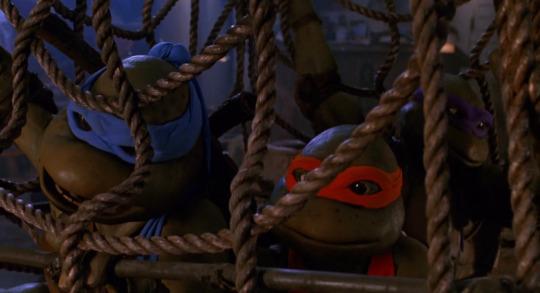



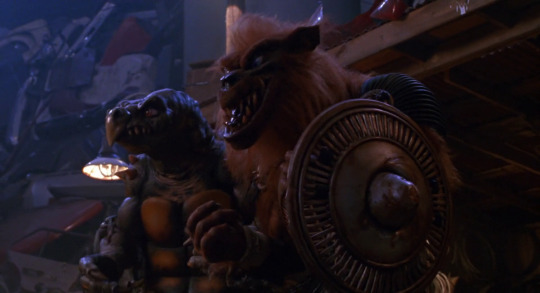

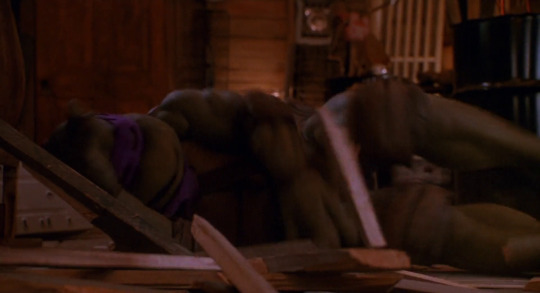

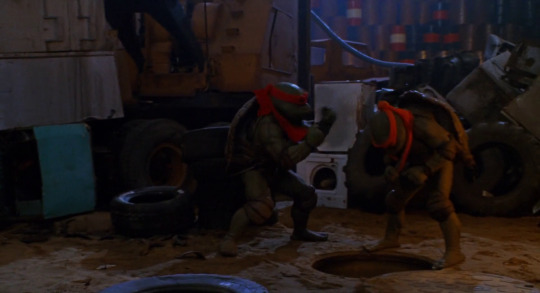

Keno relays the news of Raphael’s capture to April, and the other Turtles soon stake out the scrapyard in search of their brother. Conscious that they’re walking into a trap, the group discover Raph gagged and tied up. Shredder has the remaining Turtles placed inside a net, raised via a crane and about to be dropped on a set of scrap metal spikes until Splinter intervenes, a well-placed arrow cutting the team free ahead of time. The reunited Turtles continue to deliver quips and one-liners more than kicks or punches and find themselves vastly outmatched by the brute force of Tokka and Rahzar, with Donatello being thrown through the roof of the shack where Professor Perry is being held. After Michaelangelo discovers a manhole leading back to the sewers, the group escape with Perry underground; Tokka attempts to give chase but is too big to fit, and after getting stuck prevents the Foot from pursuing the team further.



Perry is amazed by the existence of the Turtles, and in a bit of role-reversal pieces together the events that led to their origin and recounts these to them before they can reveal their backstory themselves. After being introduced to Splinter, he goes on to explain to the group the properties of the substance that caused them to take on their current forms: “an unknown mixture of discarded chemicals was accidentally exposed to a series of radiated waves, and the resulting “ooze”, as you put it, was found to have remarkable but dangerous mutinogenic properties.” Though the cannisters were intended to be buried, one was lost down a sewer.
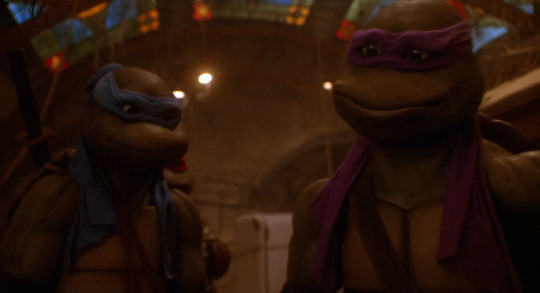
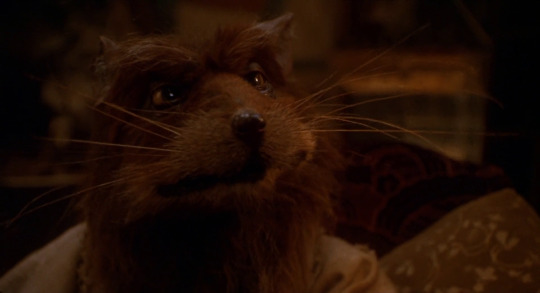
Donatello is troubled by the revelation that the Turtles were merely an accident, convinced there must be more to their origin that what Professor Perry is telling them. Splinter offers words of wisdom, telling his son to not “confuse the spectre of [their] origin with [their] present worth”, adding that “the search for a beginning rarely has so easy an end”.
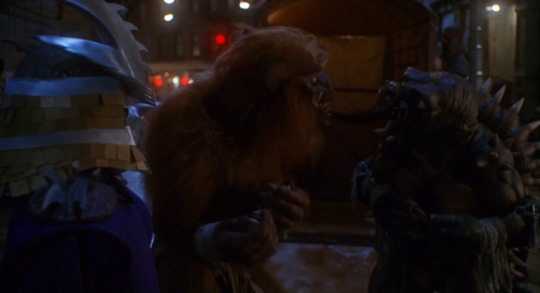





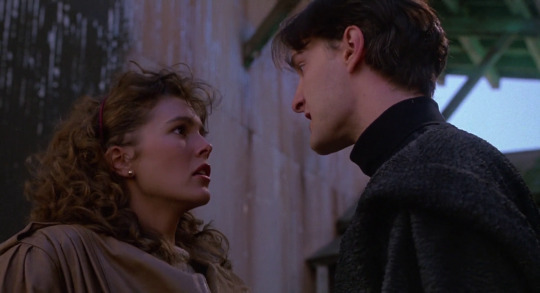

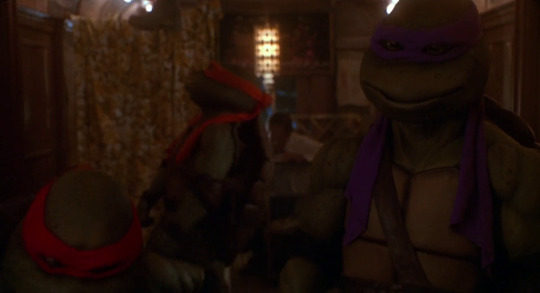
Shredder unleashes Tokka and Rahzar on the streets of New York, encouraging them to engage in general mayhem and destruction as a means of getting to the Turtles. The next day, April reports on the resulting wreckage for Channel 3; in a call-back to the first movie she corners Chief Sterns, who goes out of his way to not directly address the issue of the two mutants and refuses to do anything about them. It soon dawns on April that only the Turtles will be able to stop Tokka and Rahzar. After concluding her broadcast April is pulled into a nearby alley by a group of Foot Soldiers, one of whom removes his mask to reveal his identity as her trainee. Freddy declares that he has a “message” from Shredder for the Turtles. Later, April is seen meeting up with the Turtles in their new home, where she relays what she was told: that if the Turtles don’t appear that night at a construction site, Shredder will unleash Tokka and Rahzar in Central Park.
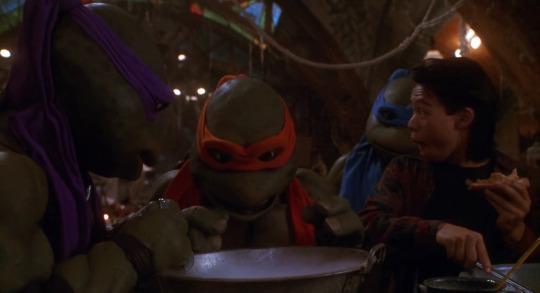
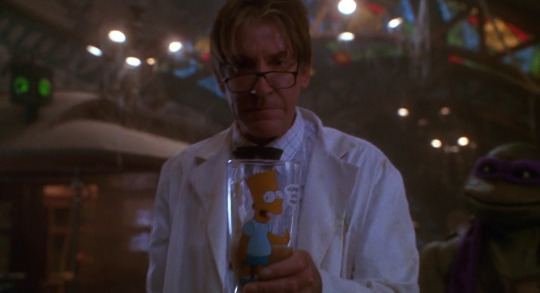
Professor Perry begins the task of creating an anti-mutagen that will revert Tokka and Rahzar back to their original forms, the Turtles offering their assistance. (Along the way Mikey accidentally drops a slice of pizza into the mix, but keeps this quiet.) The team are surprised to learn that the final substance won’t take the form of a spray, but will be a liquid that the two mutants will need to consume for it to take effect. Enjoy this shot of the anti-mutagen in a Bart Simpson glass because this movie, for better or worse, is so 1991.

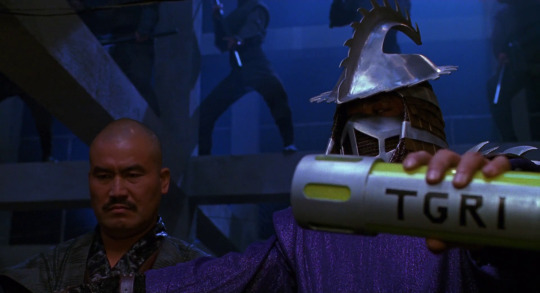
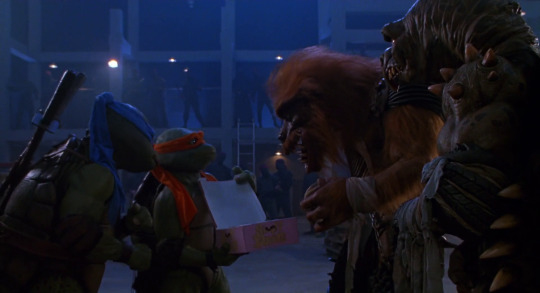

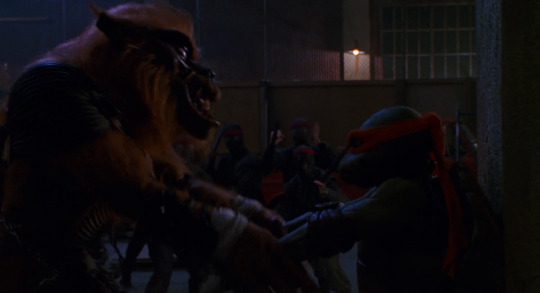

The Turtles arrive at the construction site carrying a box of donuts, soon finding themselves again face-to-face with Shredder and his army of ninjas. Wielding the remaining cannister of mutagen, Shreds tells the team that the substance which made them will now be the cause of their destruction, summoning Tokka and Rahzar. The green teens attempt to offer up the donuts as a peace offering, but the ruse falls apart when the ice cubes concealed within containing the anti-mutagen are tossed aside. Like in their prior encounter, the Turtles are hurled around, vastly overpowered by Shredder’s new mutants; soon the battle spills into a neighbouring nightclub.

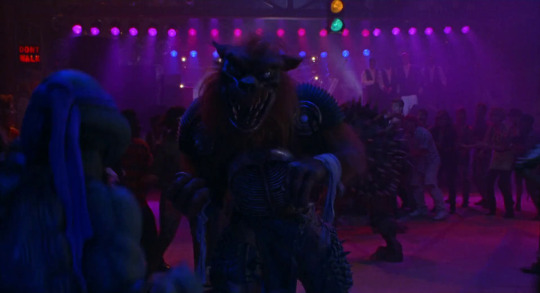


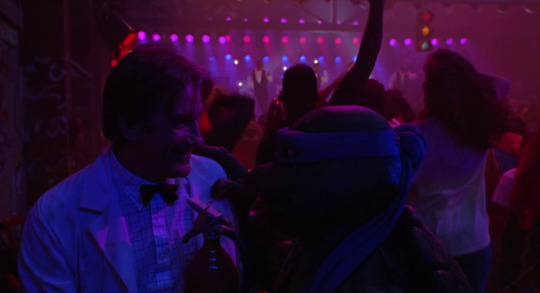
Performing in the club is one Vanilla Ice – not portraying a fictional character, but rather himself - who to what I presume is the delight of the patrons briefly pauses his set to watch in astonishment as the Ninja Turtles do battle with their oversized opponents. After the music begins playing again Ice launches into a freestyle rap about the events unfolding in front of him. Meanwhile Perry meets up with Donatello and notes that the portions of the anti-mutagen ingested by Tokka and Rahzar aren’t working as intended, the excessive consumption of CO2 making them burp profusely. Donatello suggests a further dose might act as a catalyst for the anti-mutagen, picking up a nearby fire extinguisher.


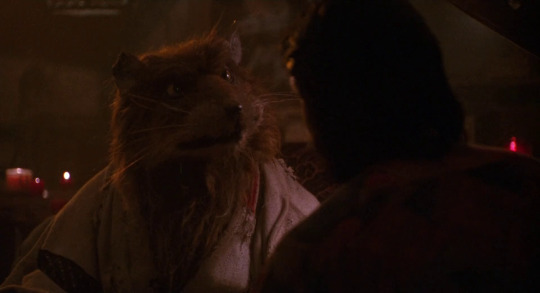
While all this is unfolding, Keno is meditating with Splinter, but can’t contain his frustration at having to stay behind while the Turtles have their big confrontation. The team’s sensei is insistent that taking on Shredder is a job only his students are suited for, but the delivery boy won’t listen and makes his exit. This all feels tacked on; Keno had already made the mistake of getting into trouble with Raphael earlier, for him to need to learn this lesson a second time comes across as if the writers are struggling to find a way to keep him involved.
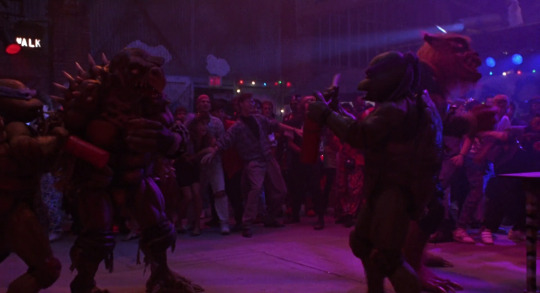

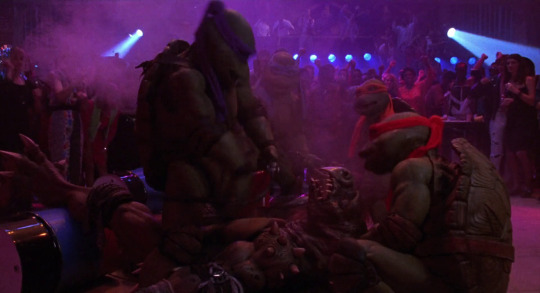


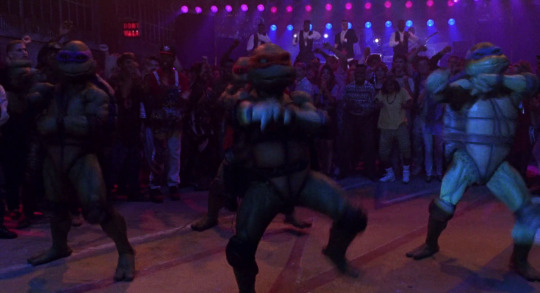
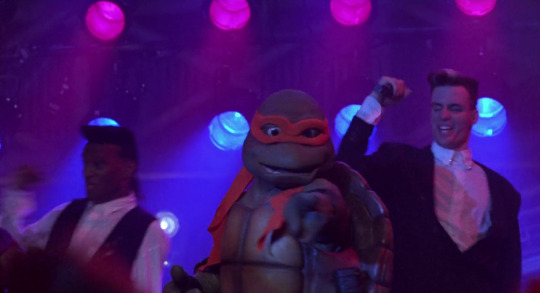

As Vanilla Ice repeats his “GO NINJA GO” chorus, the Turtles use barrels to take Tokka and Rahzar off their feet, forcing them to ingest the contents of the fire extinguishers until both doze off. The team take on further waves of Foot Soldiers as “Ninja Rap” continues; after defeating their foes the green teens get in on the dance routine themselves, ultimately joining Ice on stage in perhaps one of the most notorious scenes in TMNT history.


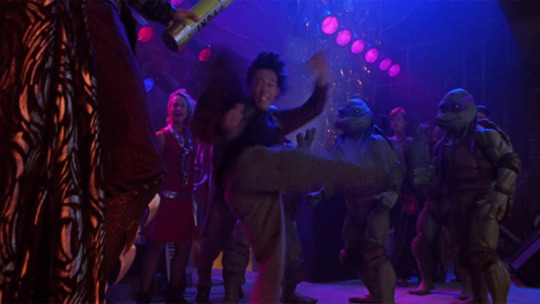

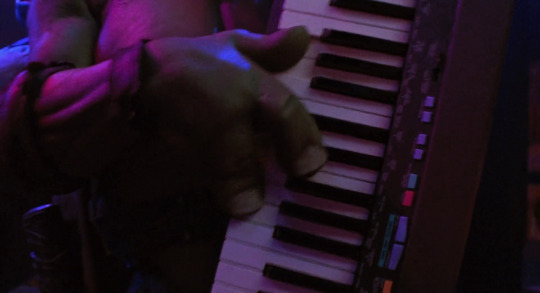
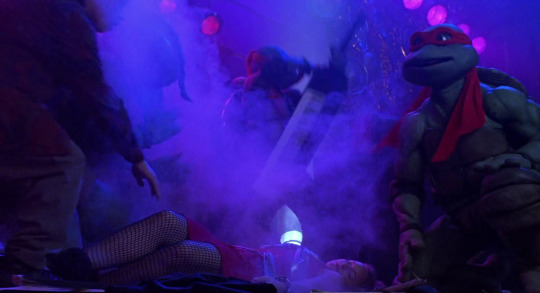

This moment that will live in infamy is mercifully interrupted, and I don’t think I’ve ever been so glad to see the Shredder in my life. Still wielding the TGRI cannister, he promises to produce further mutants, over and over again in future movies until this series becomes unprofitable – though not exactly in those words – until Keno intervenes, kicking the container out of the masked villain’s hand. Shreds attempts to rebound by taking a club-goer hostage, threatening to transform her using a small test tube also containing some of the mutagen. The Turtles use the instruments from Vanilla Ice’s band (???) to create a sound loud enough that it blows a nearby speaker, the resulting explosion sending the villain flying through a wall. On their way out, the team note that Tokka and Rahzar have reverted to their original forms.
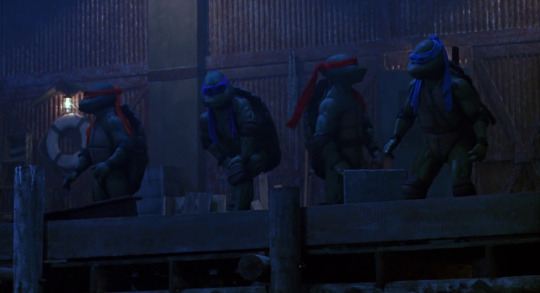
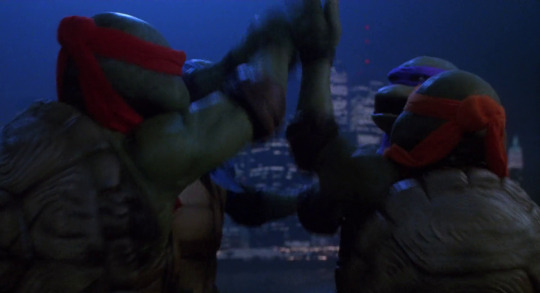

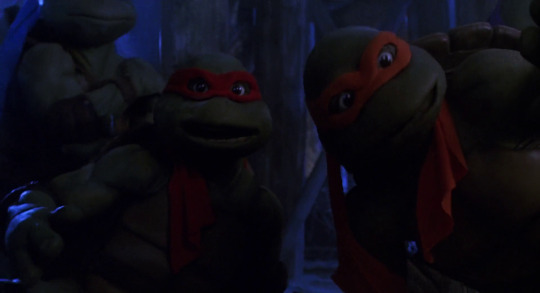
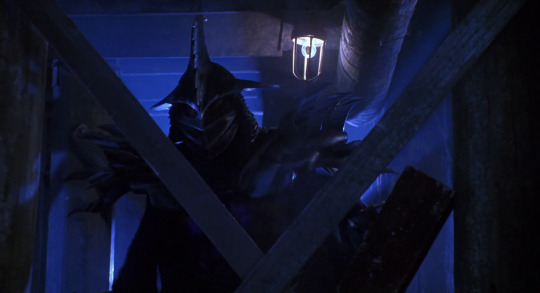




In a dockside area outside the nightclub the Turtles peer into the water, seeing no sign of their old foe. Rejoicing and cowabunga-ing follows but this turns out to be highly premature: Oroku Saki’s hand bursts through the structure of the pier ahead of a final encounter. Having consumed the contents of the test tube, he’s grown into what Donatello dubs a “Super Shredder”. Soon the Turtles find themselves beneath the pier, watching as the oversized villain wrecks everything in sight. Leonardo is briefly manhandled by the mutated foe, but instructs his team to remember the importance for ninjas of working within the confines of their environment; they are, after all, turtles, and so as the remnants of the pier crush Super Shredder, they dive out into the water nearby, safely re-emerging moments later. The group watch as, for the third time in this movie, Shredder’s hand shoots out of the ground, suggesting there’s still more fight in him, but he can’t cling on any longer, and finally passes away, for really reals this time.

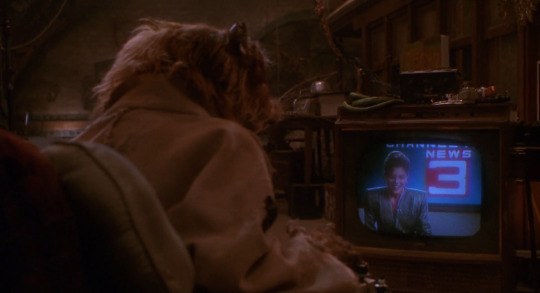

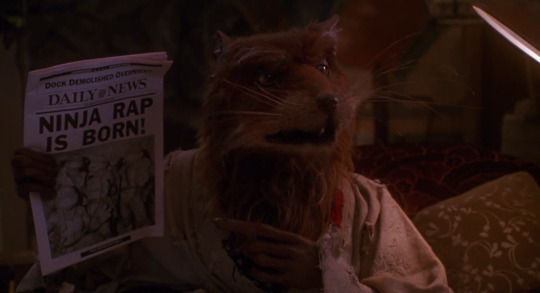
April is seen reading a thank-you note to the Turtles from Professor Perry on the news as the Turtles return to their subway home. Presumably some time has passed since the battle with Shredder as Splinter quizzes the team about their actions, wondering if they were seen during the battle; when they insist they kept a low profile, he produces a copy of the Daily News with a full-page photograph of them on the front page, accompanied by the headline “NINJA RAP IS BORN!”; a second, smaller headline reads “DOCK DEMOLISHED OVERNIGHT”.
The first Teenage Mutant Ninja Turtles movie was highly regarded even at the time, and its reputation has only grown in the three decades that have followed; it was and is a truly great comic book adaptation, one that’s aged remarkably well given that it was produced on a small budget. None of this can be said of The Secret of the Ooze, which is by no means a bad movie – at least in my estimation – but which never rises above being merely enjoyable. To go from great to kinda sorta okay still represents a decline, and it’s not hard to see why. TMNT II is burdened by the sheer size of the Turtles machine as it was in the second half of 1990, the demands from different parties insistent on shaping the future direction of this property too great, the need to have a second movie out in the wild while there was still money to be made taking precedence over crafting a coherent movie experience. Along the way the losses accumulated from the first film continued to build, some out of anyone’s control but others self-inflicted: Steve Barron, Judith Hoag, Elias Koteas and Corey Feldman are all gone and their respective replacements can only do so much. Perhaps the biggest loss of all, however, is the first movie’s ability to strike a balance in tone between the earnestness of the Mirage comics and the tomfoolery of the Fred Wolf cartoon. Now, only the tomfoolery remains. TMNT II revels in the worst impulses of the 1987 cartoon, and I say that as someone who’s plainly a huge fan of the MWS Turtles. A decision was made to alienate the older audience who embraced the first movie, the wishes of licensees and parental groups clearly taking precedence. It’s regrettable.

Speaking of regrettable decisions, I’m sure that in late 1990 shoehorning Vanilla Ice into the climax of this movie made a lot of sense. The first film benefitted from having MC Hammer’s “This Is What We Do” on its soundtrack months before “U Can’t Touch This” blew up in the summer, and no doubt his newfound name recognition helped shift additional copies of the tie-in album well into the autumn. Here, again, we see the machinations of TMNT Incorporated at work: given the enormous success of “Ice Ice Baby” in the closing months of the year, why not take things a step further and insert Hammer’s new rival into the sequel? We can laugh about it now – in 2023 the corniness of “Ninja Rap” and the visual of the Turtles cavorting with the rapper feels like a joke we’re all in on – but all of this was assuredly a misfire. By the time the movie landed in US cinemas in the spring of 1991 it was clear that Ice’s appeal was limited to his initial hit; by the summer, when TMNT II received its UK release, he was a walking punchline. And so, Ice’s prominence in the marketing materials for this movie comes across as a major blunder: an association that, with their own popularity entering the beginnings of its downswing, the Turtles didn’t need.
For the faithful, however – the legions of kids who had followed the green team on TV for years at this point – this movie’s failings would have extended far beyond the presence of one Robert Van Winkle. The first film was notable in the elements it chose to adapt from the 1987 series, but also in what it elected to omit: the Technodrome, Krang, and the Channel 6 crew were all curiously absent, and it seemed inevitable that at least some of these would be held over for the follow-up. More than any of these, however, there were two obvious players for the Turtles to encounter in a hypothetical sequel: Rocksteady and Bebop.
It’s timely that we should discuss the thorny issue of Shredder’s mutant henchmen here, a week after covering their final TV appearance in the cartoon’s eighth season; while reflecting on their role within the show I wrote about how critical they were in establishing the 1987 show’s comedic credentials, even more than the Turtles themselves. In this respect, they represent everything that differentiates the Fred Wolf TMNT from the other incarnations of the property.
It wasn’t supposed to be like this. Over the years, Kevin Eastman and Peter Laird’s position regarding Rocksteady and Bebop seems to have hovered somewhere between low-key resentment and unreserved loathing. While these characters were created early on as part of the development of TMNT into an action figure property, it’s clear that the versions of the duo which eventually made it to air were in line with the vision of David Wise and the Murakami-Wolf-Swenson studio. When that vision turned out to be incredibly profitable – not just Rocksteady and Bebop, but the pizza gags, the catchphrases, April as a reporter and everything else that had been introduced as part of the transition of the Turtles to TV and as a toy line – a situation arose where the various parties involved each felt they were responsible for the elements that had made it all possible.
This all came to a head in 1990, as the worldwide popularity of the Turtles reached its apex. The Turtlethon entries for that year’s episodes tell the story of the ill-feeling brewing between two primary camps: Mirage Studios, whose artists by that point felt that the supporting characters they had created such as Leatherhead had been mishandled in the transition to animation, and MWS, whose zanier Turtles had been what introduced the vast majority of kids to the property. Eastman & Laird had put their foot down before – nixing outlandish ideas such as an early proposal for the post-season one Turtles to have them move into the Technodrome, where they would have resided with a no-longer-villainous Baxter Stockman – but it was in season four where we really saw the fallout of these creative differences, with “Ray” and Mona Lisa the end result, the latter far more successful than the former.
It’s understandable, then, that Eastman & Laird were keen to keep MWS out of the loop as far as the live-action films went, preventing Fred Wolf and his studio from taking any potential credit (and profits) from their success. And so, for movie-goers, there would be no Dimension X, no Burne, no Irma, no Vernon, no (robotic) Foot Soldiers, and certainly no Rocksteady or Bebop. Evidently there was some push to include the mutant duo in the movie – possibly from Pressman himself and/or the studio – and so a compromise was reached. Yes, Shredder could have two creatures to do battle with the Turtles on his behalf, but they would need to be new creations, free of any association with the cartoon.
youtube
youtube
Taken in isolation, Tokka and Rahzar could be seen as merely a disappointment, a poor substitute: they are, in the worst possible way, Bebop and Rocksteady at Home, TMNT’s own fake Razor and Diesel (an ironic comparison, given that the real Diesel played Super Shredder in this very movie). Like Vanilla Ice and all the casting changes, they represent another weight around this film’s neck. But they infuriate me in a way far greater than any of TMNT II’s other failings after examining how the film was marketed. Promotional materials such as commercials from the time of The Secret of the Ooze’s release go out of their way to not show Tokka and Rahzar; to hint at the idea that the Turtles will fight two new beastly enemies, leaving viewers to connect the dots themselves. Even within the movie itself, the visual of a grey, beastly hand and a brown, furry one prior to the full reveal of the mutants plays upon our expectations that Rocksteady and Bebop are waiting behind the scrap heap veil. When that turns out to not be the case it’s a giant middle finger to the audience, whose money has already been taken.
While I can understand Eastman & Laird’s desire to have the live-action movies remain an undiluted vision of what they intended the Turtles to be, the contempt displayed for the audience here – for children – is risible in my eyes. I’m giving Kevin and Peter the benefit of the doubt and assuming these were executive decisions made within the studio, given that the final product ended up hewing far closer to the cartoon anyway, something that by all accounts was the total opposite of what they themselves wanted; I don’t believe their disdain for Rocksteady and Bebop was so great that they orchestrated this deception to trick kids, but somebody involved with this film was clearly okay with it. To be clear, the secrecy surrounding these characters only went so far - they’re showcased in detail in the half-hour special on the making of the movie - but in the greater scheme of things there was definitely some sleight of hand at work here; if you should happen to think Rocksteady and Bebop will be in TMNT II, little in the pre-release marketing would convince you otherwise.
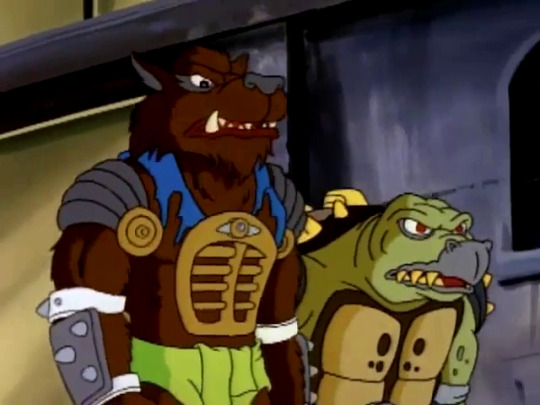
The greatest irony of all this is that Tokka and Rahzar would continue to hover around the periphery of the TMNT universe in the years that followed, but it was a surprise inclusion in season seven of the MWS cartoon that made something of them. “Dirk Savage – Mutant Hunter” was a terrific episode made better by appearances of the two mutants, re-interpreted as a duo whose friendship is so strong that when Tokka is captured, Rahzar can’t bear to be separated from him. And who was responsible for redeeming them? None other than David Wise, the same writer who helped craft Rocksteady and Bebop into the hapless henchmen whose buffoonery Eastman & Laird refused to sanction.
Today, many of the concepts created in The Secret of the Ooze remain a part of the fabric of TMNT: Tokka, Rahzar and Super Shredder all pop up on occasion in video games or as action figures. The film itself is fun fluff, the kind of thing you watch if it shows up on TV on some idle Saturday afternoon, and a representation of the exact moment where the bubble of Turtlemania burst, even if we didn’t realise it at the time. Teenage Mutant Ninja Turtles III, the most derided film of the trilogy, would follow two years later. We’ll come back to that in a few weeks, but next time on Turtlethon we jump forward again in time to 1995, where the drastic reinvention of the green teens that took place the year prior somehow still hasn’t been enough: it’s out with Shredder and in with Lord Dregg as we learn the uncover the secrets of “The Unknown Ninja”.
#Teenage Mutant Ninja Turtles#TMNT#TMNT II#1991#Turtlethon#The Secret Of The Ooze#Teenage Mutant Ninja Turtles II: The Secret of the Ooze#Tokka#Rahzar#Tokka and Rahzar#Vanilla Ice#Ninja Rap#90s films#1990s Films
4 notes
·
View notes
Photo

Mais do que qualquer outro streaming, o Netflix é o melhor lugar para conhecer a produção - contemporânea ou não - de países fora do circuito comercial. Séries italianas, indianas, coreanas ou chinesas? Tem. Filmes espanhóis, franceses e turcos? Tem também. O audiovisual do Japão, México e de países africanos também está lá. Diversidade, tão necessária no mundo, é no Netflix. Na coluna de hoje do Domingo +, no jornal A Tribuna, falo de algumas destas produções, em texto que continua com mais dicas no próximo domingo. . . . . . . . #cinemacomgustavoklein #cadernodecultura #atribuna #jornalatribuna #grupotribuna #natela #natelona #jornalismocultural #cinema #streaming #seriados #seriesdetv #teve #round6 #aliceinborderland #estudiosghibli #midnightdiner #guiaastrologico #guiaastrologicoparacoracoespartidos #astelefonistas #television #movies #newspaper #italia #japao #japan #polishmovies #polonia #coreia @stevens_standke @fernandalopesjornalista @blogdalutti @atribunasantos https://www.instagram.com/p/Ccc2tMVO4RTvA5NBDkKZazQoHX0DofnuaUes8g0/?igshid=NGJjMDIxMWI=
#cinemacomgustavoklein#cadernodecultura#atribuna#jornalatribuna#grupotribuna#natela#natelona#jornalismocultural#cinema#streaming#seriados#seriesdetv#teve#round6#aliceinborderland#estudiosghibli#midnightdiner#guiaastrologico#guiaastrologicoparacoracoespartidos#astelefonistas#television#movies#newspaper#italia#japao#japan#polishmovies#polonia#coreia
0 notes
Text
Cannes 2023: Justine Triet conquista la Palma d'Oro
Il Festival di Cannes 2023 volge al termine. È Justine Triet a trionfare in questa edizione numero 76 del festival del cinema di Cannes con il film «Anatomie d’une chute» . Purtroppo, l'Italia torna a mani vuote da Cannes 2023 ma con il grande soddisfazione di aver portato in conrcorso ben 3 film.
Festival di Cannes 2023: i premi
Un'ultima serata di grande emozioni quella della 76esima edizione del festival di Cannes. Diamo uno sguardo ai premiati:
- Palma d’oro: «Anatomie d’une chute» di Justine Triet. La regista francese, 44 anni è stata premiata per il suo thriller psicologico
- Camera d’or: Il premio alla miglior opera prima è stato vinto da«L’albero delle farfalle d’oro» del regista vietnamita Thien An Pham
- Miglior attrice: La miglior attrice della 76 edizione del Festival di Cannes è Merve Dizdar per «Kuru Otlar Ustune» («Dried Herbs») del regista turco Nuri Bilge Ceylan
- Miglior sceneggiatura: Il premio per la migliore sceneggiatura al 76/o festival di Cannes è stato vinto da Sakamoto Yuji per «Monster» di Kore-Eda Hirokazu
- Miglior attore: L’attore giapponese Koji Yakusho vince il premio come miglior attore per «Perfect Days» di Wim Wenders
- Premio della giuria: Il Premio della giuria al 76/o festival di Cannes è stato vinto da «Kuolleet Lehdet» («Le foglie morte») di Aki Kaurismaki.
- Miglior regia: Il Premio per la regia al 76/o festival di Cannes è stato vinto da Tran Anh Hung per «La passion de Dodin Bouffant».
- Grand prix: «The Zone of Interest» di Jonathan Glazer ha vinto il Grand prix di Cannes
La storia del prestigioso festival cinematografico
Il Festival del cinema di Cannes è nato nel 1946 ed è diventato uno dei più prestigiosi e influenti festival cinematografici al mondo. La sua creazione è stata ispirata dal desiderio di promuovere la cultura cinematografica e la collaborazione internazionale nel settore.
La storia del festival ebbe inizio durante la Seconda Guerra Mondiale, quando Jean Zay, Ministro dell'Istruzione Nazionale e delle Belle Arti francese, propose l'idea di un evento cinematografico internazionale che avrebbe contribuito a riunire le nazioni attraverso il linguaggio universale del cinema.
Il primo Festival del cinema di Cannes si tenne nel settembre del 1946, ma fu interrotto dopo solo un giorno a causa di alcune complicazioni organizzative e di un disaccordo tra gli organizzatori. Tuttavia, l'anno successivo, nel 1947, il festival venne ripreso con successo e si trasformò in un appuntamento annuale.
Read the full article
0 notes